Physical Address
304 North Cardinal St.
Dorchester Center, MA 02124
The nails are special cutaneous appendages that have the primary function of protecting the distal phalanx. Only primates have toenails, and whether the first primates with flat nails had an advantage over their peers by being able to remove parasites better from their bodies, thus promoting their evolutionary superiority, is a matter of fascinating speculation.
In humans, diseases and deformities of the toenails are among the most common and frustrating of foot problems. They can result from local or systemic disorders or from congenital malformations. The majority are caused by intrinsic factors and are directly or indirectly related to tinea infections. While uncommon, they can be the first presenting signs of systemic diseases such as psoriasis and endocrine disorders. Other deformities stem from mechanical problems and constitute some of the most common yet difficult foot problems for the treating physician.
Few studies have documented the frequency of nail disorders ( Table 14-1 ). During a 75-month period in practice, Krausz reported on 2788 patients displaying one or more nail disorders.
| Nail Condition | Incidence (%) |
|---|---|
| Onychocryptosis | 26 |
| Onychogryphosis or onychauxis | 23 |
| Onychophosis | 19 |
| Onychomycosis | 8 |
| Onychotrophia | 4 |
| All others | 20 |
The nail has only a few pathologic responses to disease and can demonstrate abnormalities as a manifestation of either systemic or dermatologic diseases. Before examining specific examples of nail disorders, this chapter reviews the anatomy and physiology of the toenail and supporting structures, to facilitate an understanding of the pathologic conditions.
The toenail or nail plate is composed of three layers of dense, overlapping keratinized cells. Each layer originates from a different area of the nail unit. The relatively thin dorsal layer is stiff and brittle and covers the relatively thick, softer middle layer. The deep layer is thought to be derived in part from the nail bed itself. The nail plate differs from hair or skin in that it does not desquamate skin cells. The hardness of the nail plate can be attributed to its high sulfur content and to the paucity of water within the plate. Although the nail plate is 10 times more permeable to water than the skin, it has a lower fat content and thus cannot retain water.
The normal nail plate grows distally approximately 0.03 to 0.05 mm/day, and it has a thickness of 0.5 to 1 mm. It is supported by the nail unit, or perionychium , an area of epithelial tissue that is divided into four components ( Fig. 14-1 ) : nail bed, hyponychium, proximal nail fold, and nail matrix. Synonyms are common for various anatomic units ( Table 14-2 ).
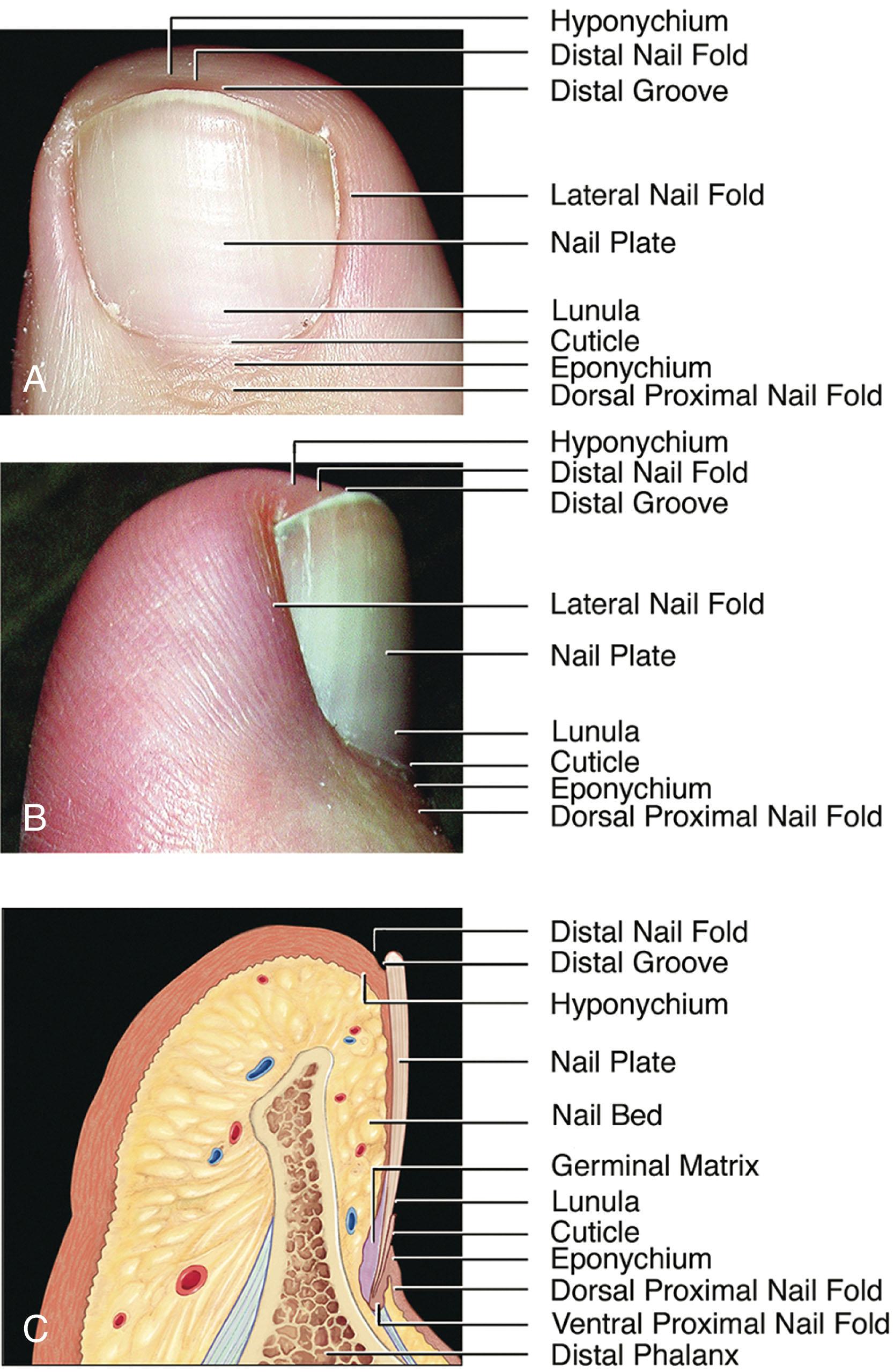
| Term | Synonym |
|---|---|
|
|
The nail plate lies on the nail bed , a roughened epithelial surface consisting of longitudinal grooves that interdigitate with corresponding grooves on the undersurface of the toenail. This interdigitation firmly bonds the nail plate to the nail bed. The nail bed or sterile matrix has only one or two layers of germinal cells, which produce the nail plate. At the distal end of the nail bed, where the nail bed and the nail plate separate, a smooth border of skin called the hyponychium forms a seal between the distal end of the toenail and the nail bed.
On the tibial and fibular borders of the toenail, the nail plate is surrounded by epidermal skin folds termed lateral nail folds . The base of the toenail is covered by the proximal nail fold , a complex structure that has germinal cells on the proximal half of the plantar surface of the nail fold. The dorsal surface of the nail fold is composed of skin on the dorsal surface of the toe. On the plantar surface of this fold, the eponychium forms a thin surface that attaches to the nail plate. The distal surfaces of these two components of the proximal nail fold comprise the cuticle.
The nail matrix or germinal matrix is the main germinal area of the toenail. The germinal matrix extends from a point just distal to the lunula and as far laterally as the entire width of the nail plate, and it extends 5 to 6 mm proximally to the edge of the cuticle and closely borders the insertion of the long extensor tendon and the interphalangeal joint. The nail matrix is seen beneath the nail plate as the lunula— the opaque, crescent-shaped area at the base of the nail. It lacks color because it is less vascular than the heavily vascularized nail bed. Distally, the nail matrix is contiguous with the nail bed. The nail matrix is covered by a small epidermal surface but does not have the epidermal ridges characteristic of the nail bed. At the distal end of the lunula, the nail matrix terminates. As noted above, at the proximal margin of the matrix, a small area on the plantar surface of the proximal nail fold appears to contribute to the growth of the nail plate. This is important to remember when trying to permanently ablate the nail by removing the germinal matrix from which the nail grows.
Most matrix germination occurs between the apex of the matrix and the distal border of the lunula. The area covered by the proximal nail fold forms the thin dorsal layer of the nail plate. The area of the lunula produces the thicker, softer middle portion of the nail plate and joins with the dorsal area to form the nail plate. Although the germinal matrix is the major origin for toenail growth, additional microscopic germinal areas of growth may be present within the lateral nail folds and the distal nail bed. These produce a thin layer of the ventral toenail plate, a factor that occasionally accounts for postoperative regrowth.
The germinal matrix cells of the nail plate are oriented longitudinally. Because of pressure from the proximal nail fold, the nail plate grows distally rather than in an elevated direction. However, if the nail matrix is injured or altered because of trauma or surgery, the nail plate may grow in an abnormal direction. Likewise, the nail plate gives a certain rigidity to the soft tissue of the distal part of the toe. If the toenail is removed or ablated, the distal nail bed and soft tissue can grow in an elevated direction because of lack of dorsal pressure from the nail ( Fig. 14-2 ). As the new nail plate begins to grow distally, it can abut these soft tissues and lead to a club nail or an ingrown toenail.
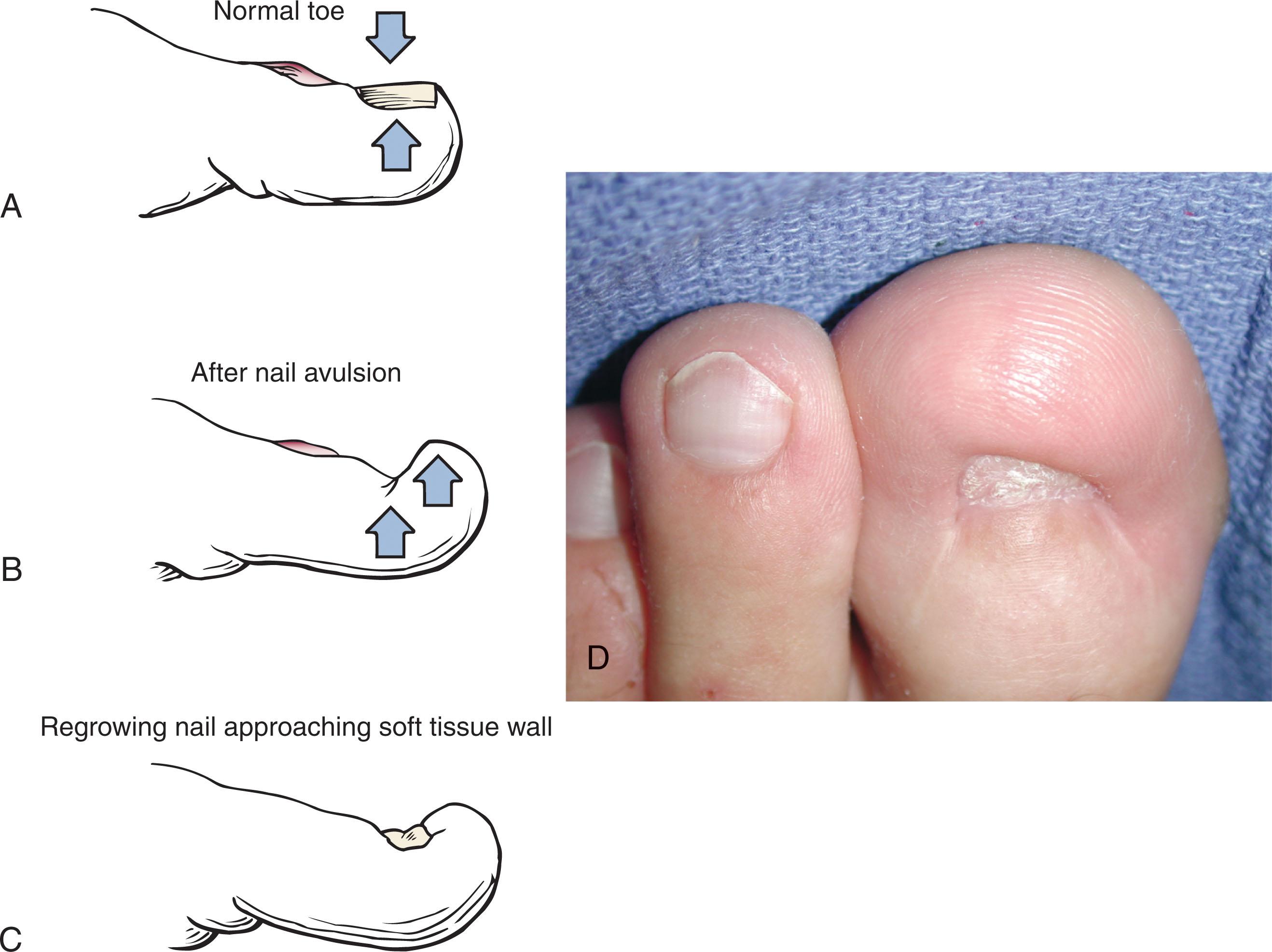
Common diseases involving the nail include infection, psoriasis, contact dermatitis and eczema, tumor, trauma, and general or systemic diseases. A useful classification for both common and uncommon nail abnormalities includes the following :
Dermatologic and systemic diseases
Congenital and genetic nail disorders
Common nail abnormalities and onychodystrophies ( Fig. 14-3 )

Common nail disorders (onychopathies) may be sub-categorized based on the anatomic structures primarily involved ( Table 14-3 ) :
Nail plate disorders
Nail bed disorders
Nail fold disorders
Nail matrix disorders
Keratinization disorders
| Location | Associated Conditions |
|---|---|
| Nail Plate |
|
| Nail Bed |
|
| Nail Fold |
|
| Nail Matrix |
|
| Keratinization Disorders |
|
These classifications provide a complete and systematic approach for a discussion of toenail disorders.
Skin disorders involving the nails are usually within the province of the dermatologist, and systemic disorders involving the nails are typically within the internist's scope of practice. Few of these entities require localized or systemic treatment. Nonetheless, an awareness of the underlying pathologic processes and an understanding of the nail changes associated with specific dermatologic and systemic disorder assist in making a definitive diagnosis. Pathologic conditions of the toenail are defined in Box 14-1 , and terms describing infections are defined in Box 14-2 .
Acral: Of or belonging to the extremities of peripheral body parts.
Anonychia: Absence of nails. When anonychia is congenital, usually all the nails are absent and the condition is permanent. It can occur temporarily from trauma or systemic or local disease. Also seen in nail-patella syndrome.
Beau lines: Transverse lines or ridges marking repeated disturbances of nail growth. May be associated with trauma or a systemic disease process ( Fig. 14-5 ).
Clubbing: Hypertrophied, curved nail with flattened angle between the nail plate and proximal fold. Associated with chronic pulmonary and cardiac disease.
Hapalonychia: Extremely soft nails that may be prone to splitting; associated with endocrine disturbances, malnutrition, and contact with strong alkali solutions.
Hemorrhage: Bleeding. Beneath toenail, bleeding may be associated with vitamin C deficiency, subacute bacterial endocarditis, and dermatologic disorders. Subungual hematoma occurs after trauma to toenail bed.
Hutchinson sign: Hyperpigmentation spreading from nail to surrounding soft tissue. Pathognomonic for melanoma.
Hyperkeratosis: Thickening of the stratum corneum layer of the epidermis.
Hyperkeratosis subungualis: Hypertrophy of the nail bed. May be associated with onychomycosis, psoriasis, and other dermatologic disorders.
Koilonychia: Concavity of the nail plate in both longitudinal and transverse axes. Associated with nutritional disorders, iron deficiency anemia, and endocrine disorders.
Lentigo: A small melanotic spot without pigment, which is potentially malignant and is unrelated to sun exposure.
Leukonychia: White spots or striations in the nail resulting from trauma and systemic diseases, such as nutritional and endocrine deficiencies.
Mees lines: Horizontal striations 1–3 mm wide associated with growth arrest.
Melanonychia: A longitudinal streak of pigment visible in or beneath the nail.
Onychauxis: Greatly thickened nail plate caused by persistent mild trauma and onychomycosis.
Onychia: Inflammation of the nail matrix, causing deformity of the nail plate and resulting from trauma, infection, and systemic diseases, such as exanthemas.
Onychitis: Inflammation of the nail.
Onychoclasis: Breakage of the nail plate.
Onychocryptosis: Ingrowing of nails or, more specifically, hypertrophy of the nail lateral fold; also referred to as hypertrophied ungualabia or unguis incarnatus ; one of the most common pathologic conditions of the toenail.
Onychogryphosis: “Claw nail” or “ram's horn nail”; extreme hypertrophy of the nail gives the appearance of a claw or horn. May be congenital or a symptom of many chronic systemic diseases, such as tinea infections. See onychauxis .
Onycholysis: Loosening of the nail plate, beginning along the distal or free edge when trauma, injury by chemical agents, or diseases loosen the nail plate. Associated with psoriasis, onychomycosis, acute fevers, and syphilis (see Fig. 14-3B ).
Onychoma: Tumor of the nail unit.
Onychomadesis: Complete loss of the nail plate.
Onychomalacia: Softening of the nail.
Onychomycosis: Fungal infection of the nail associated with fungal disease of the foot ( Fig. 14-29 ).
Onychophosis: Accumulation of callus within the lateral groove, involving the great toe more often than the lesser toes.
Onychoptosis defluvium: Nail shedding.
Onychorrhexis: Longitudinal ridging and splitting of nails caused by dermatoses, nail infections, systemic diseases, senility, or injury by chemical agents.
Onychoschizia: Lamination and scaling away of nails in thin layers caused by dermatoses, syphilis, or chemical agents ( Fig. 14-40 ).
Onychosis: Disease or deformity of the nail plate. Also called onychopathy .
Onychotrophia: Atrophy or failure of development of a nail caused by trauma, infection, endocrine dysfunction, or systemic disease.
Orthonyx: Mechanical bracing of nails to correct curvature.
Pachyonychia: Extreme thickening of all the nails. Thickening is more solid and more regular than in onychogryphosis. Usually, a congenital condition associated with hyperkeratosis of the palms and soles.
Paronychia: Inflammation of soft tissues around the nail margin, which can occur after trauma or infection (bacterial or fungal).
Parrot Beak nail: Hooked nail deformity where nail curves palmarward. May be caused by tight closure of a fingertip amputation ( Fig. 14-31 ).
Pincer nail: Ingrown toenail with both sides of the nail turned in, nearly forming a complete circle.
Pitting: Tiny depressions in the nail surface; associated with psoriasis and alopecia areata. Also known as “stippling.”
Pterygium: Growth of cuticle distal to the nail plate, splitting the nail into two or more portions that gradually decrease in size as the growth widens. Can result from trauma and decreased circulation in the toes (see Fig. 14-3E ).
Stratum corneum: The most superficial layer of the epidermis.
Subungual hematoma: Blood that has collected beneath the nail plate, usually secondary to trauma. Also known as “tennis toe” or “jogger's toe.”
Trachyonychia: “Rough nails.” A reaction or morphologic pattern with various clinical appearances and causes (see Figs. 14-3A ).
Yellow nail syndrome: Keratohyalin granules within the nail plate seen only with electron microscopy.
Ecthyma: Ulcerative infection usually caused by group A β-hemolytic streptococci. Often occurs at the site of minor trauma, frequently on the dorsal aspect of the foot.
Erythrasma: Chronic superficial bacterial infection involving the web space. The peripheral edge may be sharply demarcated and scaling.
Impetigo: Contagious skin infection caused by group A streptococci or Staphylococcus aureus and characterized by discrete vesicles with erythematous borders. Pustules may rupture, discharging a purulent fluid that dries and forms yellowish crust.
Intertrigo: Superficial dermatitis on adjacent skin surfaces, such as between toes, caused by moisture and friction and characterized by maceration, erythema, itching, and burning.
Whitlow: Infection, often viral, occurring near the nail. Because of the similarity in appearance, subungual melanoma has been termed melanotic whitlow .
Psoriasis of the toenails often accompanies cutaneous disease, and patients often mistake it for fungal involvement of the nail ( Fig. 14-4 ). Involvement of the nails is seen in 80% of patients with psoriatic arthritis and in 50% to 80% of patients who have psoriasis without arthritis. The most severe form of nail involvement with psoriasis, which sometimes involves shedding and loss of the nail (onychomadesis) , is associated with arthritic changes. Many patients without arthritic changes who have psoriasis have the following abnormal findings in either their toenails or their fingernails :
Stippling or geographic pitting (tiny, often grooved depressions in the surface of the nail plate) (see Fig. 14-4A ), which is not unique to psoriasis and is seen in alopecia areata
Onycholysis , especially laterally and distally, sometimes with yellowing and opacity of the nail plate, which separates and then detaches from the nail bed (see Fig. 14-4B–D )
Crumbling of the nail plate
Staining of the nail (oil spot lesions) (see Fig. 14-4B and C )
Subungual keratosis (see Fig. 14-4E )
Possibly extensive skin involvement (see Fig. 11-4E ).

Often these changes are confused with onychomycosis. Hence, before antifungal therapy is instituted, scrapings of the nails should be made for microscopic examination and/or speciation (e.g., fungal cultures or polymerase chain reaction [PCR]) to identify the presence of fungus.
Treatment of psoriatic nail changes of the feet is generally unsatisfactory. Intralesional injection of corticosteroids may be effective for treating psoriasis in fingernails, particularly with nail matrix involvement, but similar therapy for involved toenails is administered less frequently. Topical treatment with steroid and vitamin D analogues may be used for nail bed involvement. Systemic treatment for psoriasis, including disease-modifying biologic agents such as secukinumab, a monoclonal antibody to interleukin-17A, and other new targeted treatments may be considered.
Eczema and contact dermatitis often involve not only the skin on the dorsum of the toes but also the lateral and proximal nail folds. With chronic inflammatory changes, transverse ridging and scaling as well as discoloration of the nail plate can develop. Accumulation of serous fluid can lead to onycholysis and subsequent onychomadesis. Allergic reaction to nail polish, resins, dyes, solvents, detergents, and other chemicals can cause eczema, and atopic dermatitis with no known cause can lead to the development of similar nail changes.
With the resolution of acute inflammation, the chronic changes of fissuring and dryness may be treated with topical corticosteroids. The primary objective of the treatment of eczema and contact dermatitis is the resolution of the acute inflammatory process surrounding the toenail unit.
Bacterial infections occur commonly in the feet and are divided into primary and secondary pyodermas. Impetigo is a superficial skin infection that is often caused by Staphylococcus and/or Streptococcus species, and it usually affects younger children. The typical lesion consists of a thin-walled vesicle on an erythematous base. The vesicles form yellow crusts, and peripheral extension results in irregular serpiginous lesions. The lesions are common on the face but can occur anywhere on the body except the palms and soles. Ecthyma is a form of pyoderma that begins as small vesicles or pustules on an erythematous base and quickly develops a purulent, irregular ulcer. These lesions are common on the lower extremities and, as with impetigo, readily respond to systemic antibiotics. Burow compresses are helpful in removing the crusts, and topical antibiotic ointment is usually applied several times a day ( Box 14-3 ).
Burow solution: Aluminum sulfate in water (1 : 40 dilution)
Carbolic acid (phenol): 88% carbolic acid, 70% isopropyl alcohol
Castellani paint: Mixture of phenol, alcohol, water, resorcinol, acetone, and fuchsin
Whitfield ointment: 12% benzoic acid, 6% salicylic acid
Secondary pyodermas that affect the feet can be grouped into three categories: infectious eczematoid dermatitis, infected intertrigo, and miscellaneous pyogenic infections of the web space.
Infectious eczematoid dermatitis results from a discharge of wet drainage seeping over the skin from underlying cellulitis or pyodermic infection. Autoinoculation often occurs, and the infection spreads by contiguous drainage.
Infected intertrigo results from friction, moisture, and sweat retention. It is common between the toes, where it is often diagnosed as a tinea infection. Treatment consists of promoting dryness with cool, drying compresses and a bland absorbent powder. Secondary infection is treated with an appropriate topical antibiotic.
Miscellaneous pyogenic infections of the web space, which are caused by gram-negative bacteria such as Pseudomonas and Proteus , produce clinical pyodermic infections that are resistant to the usual antibacterial therapy. Identification of the organisms may be difficult, and broad-spectrum antibiotic therapy may be appropriate initially.
The infection should be carefully investigated to determine the presence of any underlying systemic disorders, such as diabetes, lymphoma, or an immunodeficiency syndrome, that could predispose the patient to such cutaneous infections. Amonette and Rosenberg found that the best treatment regimen was topical management with a combination of bed rest, exposure to air, and application of silver nitrate solution, Castellani paint, and gentamicin sulfate cream. Erythrasma is often seen in intertriginous areas, such as the web spaces. The causative organism is Corynebacterium minutissimum , which produces a well-demarcated, reddish-brown, fine desquamation that fluoresces orange-red or coral-pink under a Wood lamp. Wearing loose stockings and shoes and using antibacterial soaps usually prevent this infection or eliminate it after it has been established. Treatment occasionally requires appropriate oral antibiotics.
Not every form of intertrigo of the web space is linked to infection by a fungal or bacterial organism. With psoriasis, the skin of the feet can be extensively involved, and usually the web space is involved as well. A therapeutic trial of a topical steroid cream can effectively eliminate this form of intertrigo.
Diseases of the toenail can accompany many systemic disease processes, but the nail is underused as an aid in diagnosing systemic diseases. Often a provisional diagnosis of a fungal infection or trauma is made when, instead, a systemic disease process has caused changes in the color, shape, rate of growth, or texture of the toenail. Although many of these changes are nonspecific, they can give a diagnostician reason to suspect the presence of a systemic disease.
The consistency and color of the nail plate can change with systemic disease. Several eponyms are associated with these changes and, although confusing, they are in general used for specific pathologic descriptions. These include the Beau lines, Mees lines, Muehrcke lines, half-and-half nail, blue nail, and Terry nail.
With the sudden arrest in longitudinal nail growth, a transverse sulcus, a Beau line develops, which is 0.1 to 0.5 mm deep (see Fig. 14-5A ). With further growth of the nail plate, the Beau line progresses distally. This is associated with severe febrile episodes, peripheral vascular disease, diabetes, trauma, Hodgkin disease, and infections such as malaria, rheumatic fever, syphilis, leprosy, typhoid fever, and various parasitic infections.
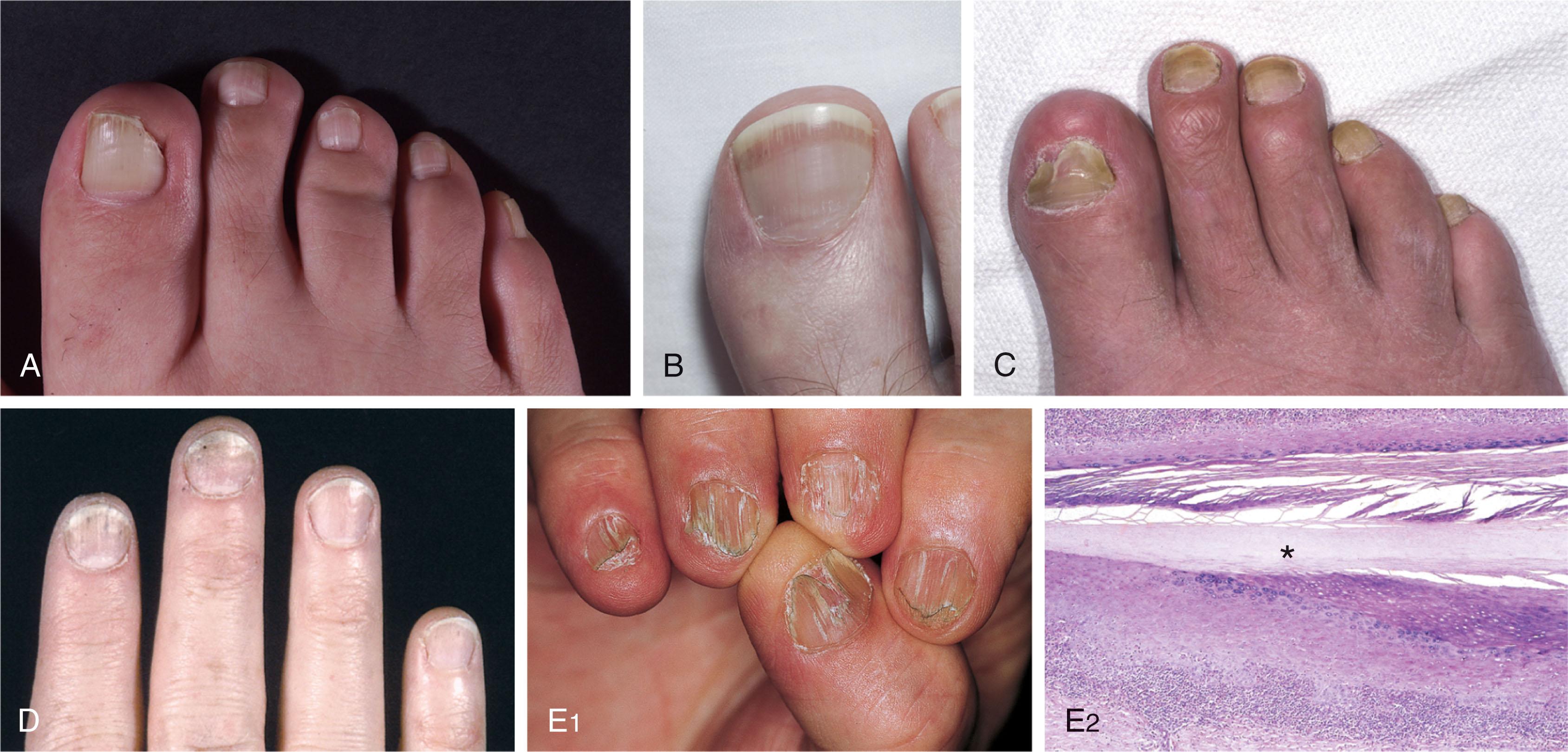
Mees lines are also associated with growth arrest of the nail plate. Mees lines are horizontal striations that typically involve more than one nail. They are usually 1 to 3 mm wide and are associated with Hodgkin disease, myocardial infarction, malaria, and arsenic and thallium poisoning.
Muehrcke lines are white lines that occur in pairs, parallel to the lunula, and do not progress distally with nail plate growth. They occur with hypoalbuminemia and the nephrotic syndrome as well as with chronic liver disease.
Half-and-half nail is a biphasic discoloration of the nail in which the distal portion is brown, red, or pink, and the proximal portion appears normal. Half-and-half nails are associated with chronic liver disease and chronic kidney disease.
Blue nail or blue-gray nail is a bluish discoloration of the nail that is associated with subungual hematoma, melanotic whitlow, and poor oxygen perfusion in methemoglobinemia, pulmonary disease, and cyanosis.
In the Terry nail , characteristic changes involve opacification of the nail plate with a 1- to 3-mm pinkish band at the distal edge of the nail plate. Often, this condition is connected with chronic changes associated with diabetes mellitus and liver disease (see Fig. 14-5B ).
Other pathologic nail conditions are often associated with systemic disease entities. These nail changes may be manifested in cardiovascular disorders (yellow nail syndrome or splinter hemorrhages; see Fig. 14-5C and D and Table 14-4 ), hematologic diseases ( Table 14-5 ), endocrine disorders ( Table 14-6 ), connective tissue diseases ( Table 14-7 ), local and systemic infections ( Table 14-8 ), neoplasia ( Table 14-9 ), and renal, hepatic, pulmonary, and gastrointestinal disorders ( Table 14-10 ).
| Disease | Pathologic Changes |
|---|---|
| Arterial emboli | Splinter hemorrhages |
| Arteriosclerosis obliterans | Leukonychia partialis |
| Bacterial endocarditis | Clubbing, splinter hemorrhages |
| Hypertension | Splinter hemorrhages |
| Ischemia | Onycholysis, pterygium |
| Mitral stenosis | Splinter hemorrhages |
| Myocardial infarction | Mees lines, yellow nail syndrome |
| Vasculitis | Splinter hemorrhages |
| Disease | Pathologic Changes |
|---|---|
| Cryoglobulinemia | Splinter hemorrhages |
| Hemochromatosis | Brittleness, koilonychia, leukonychia, longitudinal striations, splinter hemorrhages |
| Hemophilia | Ingrown toenails, pyogenic granulomata |
| Histiocytosis X | Onycholysis, pitting, splinter hemorrhages |
| Hodgkin disease | Leukonychia partialis, Mees lines, yellow nail syndrome |
| Hypochromic anemia | Koilonychia |
| Idiopathic hemochromatosis | Brittleness, koilonychia, longitudinal striations, splinter hemorrhages |
| Osler-Weber-Rendu disease | Splinter hemorrhages, telangiectasia |
| Polycythemia rubra vera | Clubbing, koilonychia |
| Porphyria | Onycholysis |
| Sickle cell anemia | Leukonychia, Mees lines, splinter hemorrhages |
| Thrombocytopenia | Splinter hemorrhages |
| Disease | Pathologic Changes |
|---|---|
| Addison disease | Brown bands, diffuse hyperpigmentation, leukonychia, yellow nail syndrome, longitudinal pigmented deep yellow bands |
| Diabetes mellitus | Beau lines, koilonychia, leukonychia, onychauxis, onychomadesis, paronychia, pitting of nail plate, proximal nail bed telangiectasia, pterygium, splinter hemorrhages, yellow nail syndrome |
| Hyperthyroidism | Clubbing, increased nail growth, onycholysis, splinter hemorrhages, yellow nail syndrome |
| Hypothyroidism | Onycholysis, koilonychia, yellow nail syndrome |
| Thyroiditis | Yellow nail syndrome |
| Thyrotoxicosis | Koilonychia, onychomadesis, splinter hemorrhages, yellow nail syndrome |
| Disease | Pathologic Changes |
|---|---|
| Alopecia areata | Leukonychia partialis, nail pitting |
| Atopic dermatitis/eczema | Onycholysis, onychorrhexis |
| Lichen planus | Atrophy of nail plate, onycholysis, onychorrhexis, pterygium |
| Psoriasis | Beau lines, leukonychia, Mees lines, nail pitting, onycholysis, splinter hemorrhages |
| Raynaud syndrome | Koilonychia, yellow nail syndrome |
| Reiter syndrome | Onycholysis, nail pitting |
| Rheumatoid arthritis | Splinter hemorrhages, yellow nail syndrome |
| Scleroderma (62% of patients) | Absent lunula, koilonychia, leukonychia, onycholysis, onychorrhexis, pterygium |
| Systemic lupus erythematosus | Clubbing, hyperpigmented periungual tissue, nail pitting, onycholysis, subungual petechiae, yellow nail syndrome |
| Disease | Pathologic Changes |
|---|---|
| Bacterial endocarditis | Clubbing, splinter hemorrhages |
| Hansen disease | Loss of lunula, nail plate dystrophy, onychogryphosis, onychauxis, onycholysis, onychodesis, onychomadesis, onychorrhexis |
| Malaria | Grayish nail bed, leukonychia |
| Measles | Onychomadesis |
| Recurrent cellulitis | Yellow nail syndrome |
| Scarlet fever | Onychomadesis |
| Syphilis | Koilonychia, leukonychia partialis, onychauxis, onychia, onycholysis, onychomadesis, onychorrhexis, paronychia |
| Trichinosis | Splinter hemorrhages, leukonychia |
| Tuberculosis | Leukonychia partialis, yellow nail syndrome |
| Typhoid fever | Leukonychia, Mees lines |
| Yaws and pinta | Hypopigmentation, nail atrophy, onychia, onychauxis, paronychia, pterygium |
| Disease | Pathologic Changes |
|---|---|
| Breast carcinoma | Yellow nail syndrome |
| Bronchogenic carcinoma | Clubbing, Muehrcke lines, onycholysis |
| Hodgkin disease | Leukonychia partialis, Mees lines, yellow nail syndrome |
| Laryngeal carcinoma | Yellow nail syndrome |
| Metastatic malignant melanoma | Clubbing, yellow nail syndrome |
| Multiple myeloma | Onycholysis |
| Disease | Pathologic Changes |
|---|---|
| Hepatic | |
| Chronic hepatitis | Half-and-half nails, leukonychia |
| Cirrrhosis | Clubbing, Muehrcke lines, splinter hemorrhages, Terry nails |
| Renal | |
| Nephritis | Leukonychia |
| Nephrotic syndrome | Half-and-half nails, Muehrcke lines, yellow nail syndrome |
| Renal failure | Brown lunula, half-and-half nails, Mees lines |
| Pulmonary | |
| Asthma | Yellow nail syndrome |
| Bronchiectasis | Clubbing, inflammation of nail fold and nail bed, onychauxis, onycholysis, yellow nail syndrome |
| Chronic bronchitis | Clubbing, yellow nail syndrome |
| Interstitial pneumonia | Clubbing, yellow nail syndrome |
| Pleural effusion | Clubbing, onycholysis, yellow nail syndrome, leukonychia, Mees lines |
| Pneumonia | Clubbing, yellow nail syndrome |
| Pulmonary fibrosis | Cyanosis, multiple paronychia, nail pitting |
| Pulmonary tuberculosis | Onychauxis |
| Gastrointestinal | |
| Peptic ulcer disease | Splinter hemorrhages |
| Plummer-Vinson syndrome | Koilonychia |
| Postgastrectomy syndrome | Koilonychia |
| Regional enteritis | Clubbing |
| Ulcerative colitis | Clubbing, leukonychia |
Heritable traits can influence the appearance of toenails. Many genetic diseases with collagen abnormalities are associated with dermatologic abnormalities and hair and nail disorders ( Table 14-11 ). These constitute a heterogenous group of ectodermal dysplasias, with affected genes expressed in nail bed morphogenesis and development. No therapies are available for any of the inherited nail disorders.
| Disease or Syndrome | Genetic Inheritance | Pathologic Nail Findings |
|---|---|---|
| Darier disease | Autosomal dominant | Longitudinal red-and-white striations, atrophy or hypertrophy of nail plate, splinter hemorrhages, distal subungual wedge-shaped keratoses |
| Pachyonychia congenita | Autosomal dominant | Massive hypertrophy of nail plates, brown or yellow discoloration |
| Nail-patella syndrome | Autosomal dominant | Atrophy or hemiatrophy of nail, triangular-shaped lunula |
| Dyskeratosis congenita | X-linked recessive or autosomal dominant | Atrophy of nail plate, ridging, fusion of proximal nail fold |
| DOOR syndrome | Autosomal recessive | Anonychia or atrophic nails |
| Frizzled D 6 caused isolated nail dystrophy | Autosomal recessive | Nail dysplasia, hyponychia, onycholysis, onychauxis |
Darier disease (Darier-White disease or keratosis follicularis) is an autosomal dominant disease characterized by distal subungual wedge-shaped keratoses, red and white longitudinal striations ( Fig. 14-6A, B , and E ), splinter hemorrhages, notching of the distal nail plate, subungual hyperkeratosis, and thinning of the nail plate with splintering along the edge.
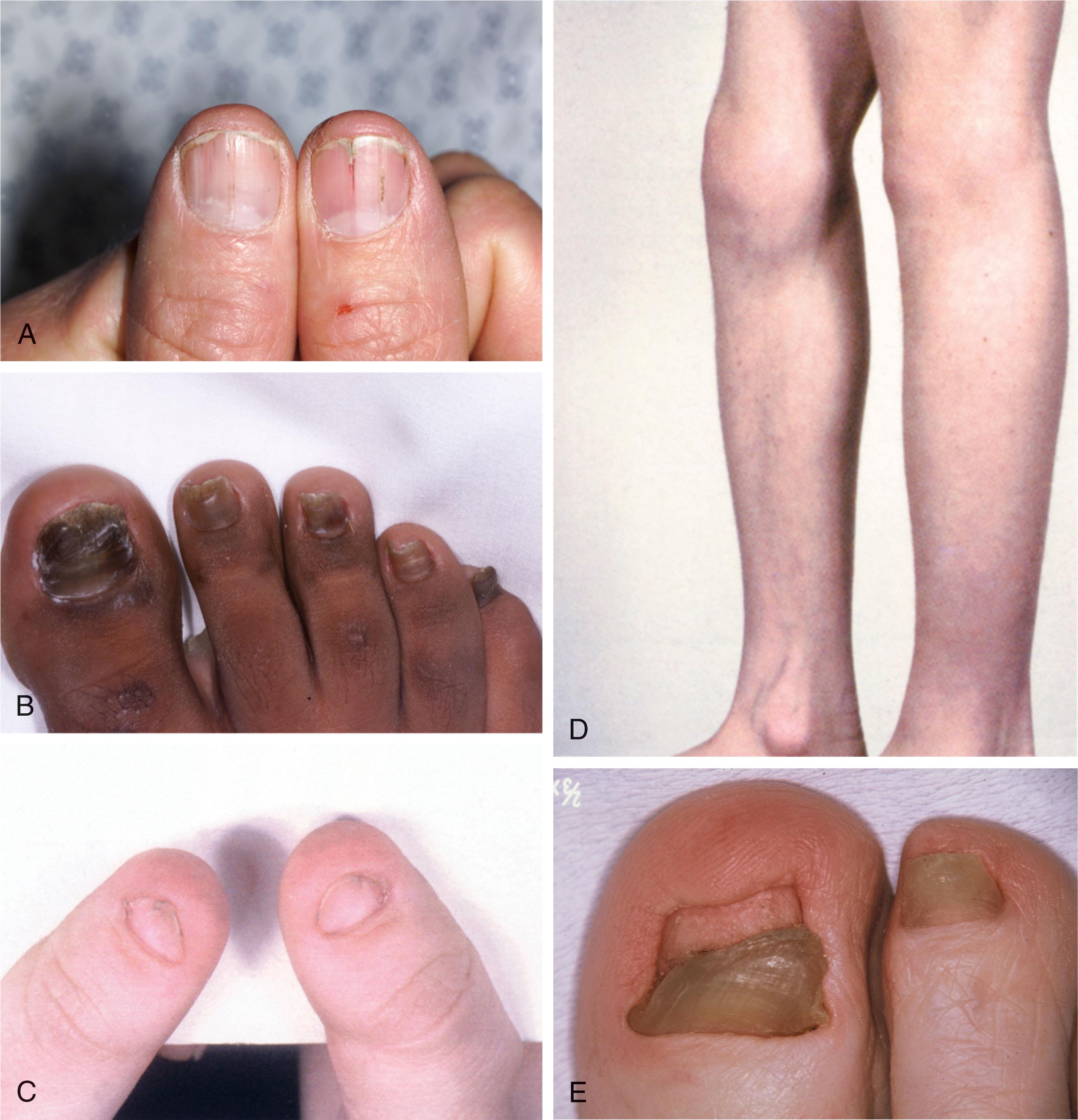
Pachyonychia congenita (Jadassohn-Lewandowsky syndrome), another autosomal dominant genetic disorder, is characterized by hypertrophy of the nail plate, with severe thickening and yellowish-brown discoloration of the nail plate ( Fig. 14-6C ). The extreme thickening is more solid and more regular than with onychogryphosis and is accompanied by palmar and plantar keratoses. The thickening of the nail plate can lead to elevation of the distal nail plate and an incurved and elevated toenail. Tauber et al reported a case of pachyonychia congenita and reviewed published reports of this disease.
The nail-patella syndrome (onychoosteodysplasia) is an autosomal dominant disease characterized by a triangular lunula and total atrophy or hemiatrophy of the nail plate ( Fig. 14-6D ). Other orthopaedic conditions associated with this disease include subluxation or dislocation of the radial head, presence of iliac horns, joint hypermobility, and a subluxated or dislocated hypoplastic patella.
Dyskeratosis congenita (Zinsser-Cole-Engman syndrome) can be transmitted as an autosomal dominant or X-linked recessive trait and is characterized by ridging and thinning or atrophy of the nail plate.
DOOR syndrome ( d eafness, o nychodystrophy, o steodystrophy, and mental r etardation) is an autosomal recessive trait characterized by mental retardation and deafness. It may also be associated with absent or atrophic nails and curved fifth digits.
Congenital malalignment of the hallux toenail may be transmitted by an autosomal dominant gene of variable expression ( Fig. 14-6E ). It is characterized by lateral deviation of the long axis of the nail relative to the distal phalanx. Complications of this condition are local, such as perionychium onychocryptosis. In one review, 50% of cases spontaneously improved or resolved; however, the misdirected nail matrix can be rotated surgically.
Congenital nail abnormalities are errors of development that can produce other anomalies, such as anonychia (absence of the nails) and polyonychia (presence of more than one nail on a digit) or micronychia (small nails) ( Fig. 14-7 ). Anonychia was the first isolated nail disorder associated with a specific genetic mutation in 2006. More mutations associated with specific nail findings will be discovered due to the new abundance of genetic sequencing data.
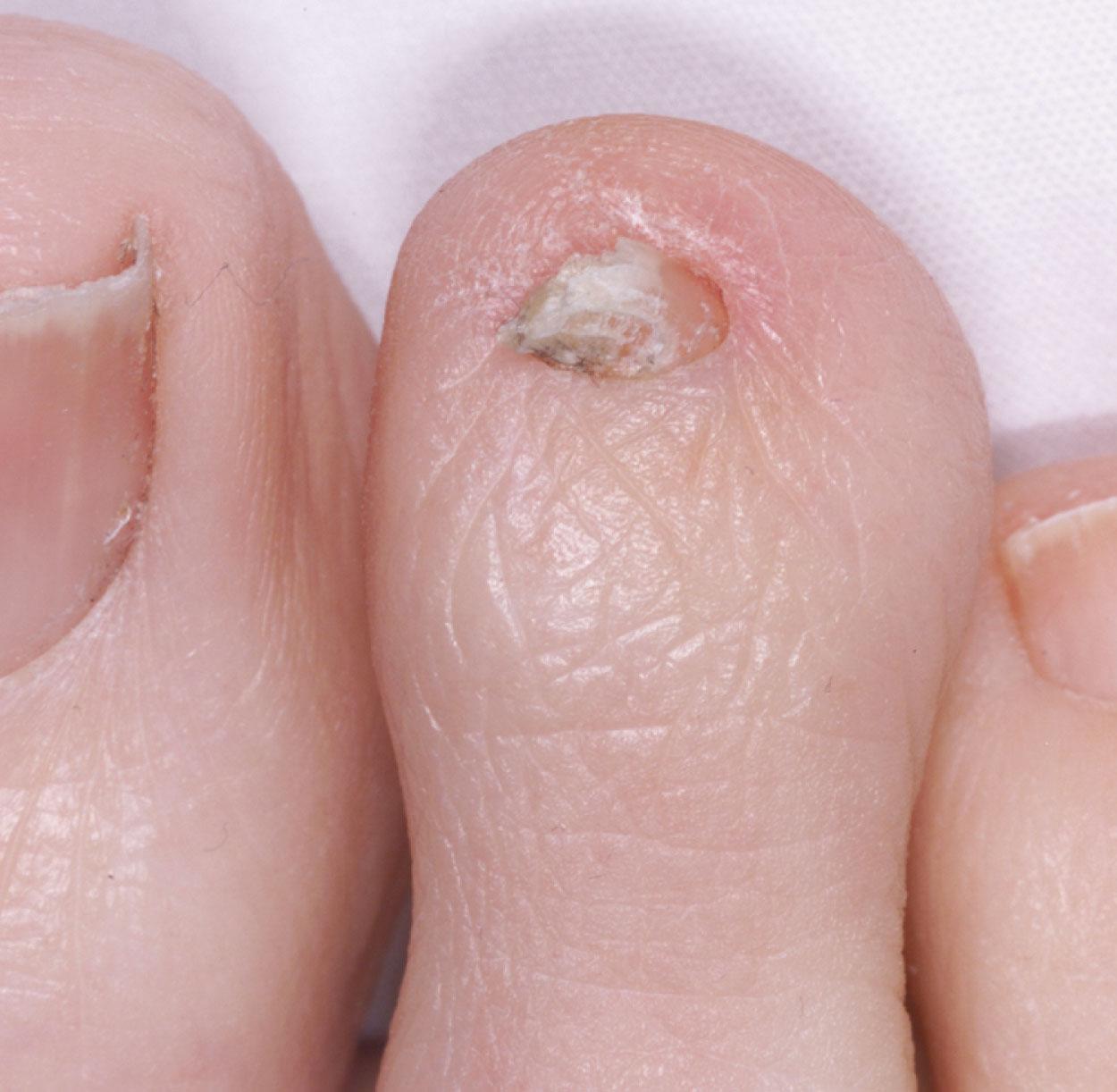
The nail plate and nail bed can be damaged by trauma. Injury to the germinal matrix can cause abnormalities such as ridging, pitting, and grooving. After an injury to the toenail, the regrowth can be a thickened, discolored nail, and after a toenail is lost, a new nail plate can grow abnormally or normally. Trauma to the distal phalanx can cause a subungual exostosis, which often causes nail plate deformity, and an osseous injury to the distal phalanx can cause callus formation that can affect the new toenail. Thickening of the distal phalanx can cause an incurved toenail that pinches the underlying soft tissue.
Trauma to the nail plate may be caused by biomechanical abnormalities as well (see later discussion on subungual hematoma). The second toe can compress the lateral nail fold of the great toe adjacent to the second toe, causing an overgrowth of soft tissue with secondary infection. With more acute trauma, when the nail bed over the distal phalanx is crushed, after the nail bed is repaired, the fragmented nail can be replaced and secured with 2-octyl cyanoacrylate (Dermabond; Ethicon, Somerville, NJ). This material creates a bond between the nail fragments and the skin for 7 to 14 days, when the new nail pushes it off. The material serves as a rigid splint for a fracture as well as a biologic covering to minimize desiccation and hyperkeratinization of the nail matrix. It also prevents the cuticle from adhering to the underlying germinal matrix.
Similar to nail plate repairs in the hand, germinal matrix and nail bed repairs in the foot may be made under loupe magnification, using 7-0 absorbable suture to repair the tissue, with the intention of preventing functional or cosmetic problems. Replacing the nail prevents the eponychium from adhering to the nail bed. It may be held in place with a distal suture or two side sutures (5-0 nylon), which are removed at 7 to 10 days to prevent an epithelialized tract. If the nail is crushed too severely, similar to hand injuries, 0.020-inch silicon sheeting may be placed under the proximal nail fold to protect the nail fold. The surgeon could also remove the nail longitudinally, excise the scar tissue or lesion, and undermine the nail bed all the way to the perionychial tissues to achieve a tension-free closure, as is done for split fingernail injuries. A figure-of-eight suture may be used to hold the nail in place.
Create two small slits in the distal aspect of the nail plate.
Place the nail plate under the eponychial fold.
A 4.0 absorbable or nonabsorbable suture is placed into one side of the paronychium distal to proximal.
The suture is passed through the notches in the distal nail plate.
The suture is placed in the contralateral paronychium from distal to proximal ( Fig. 14-8 ).
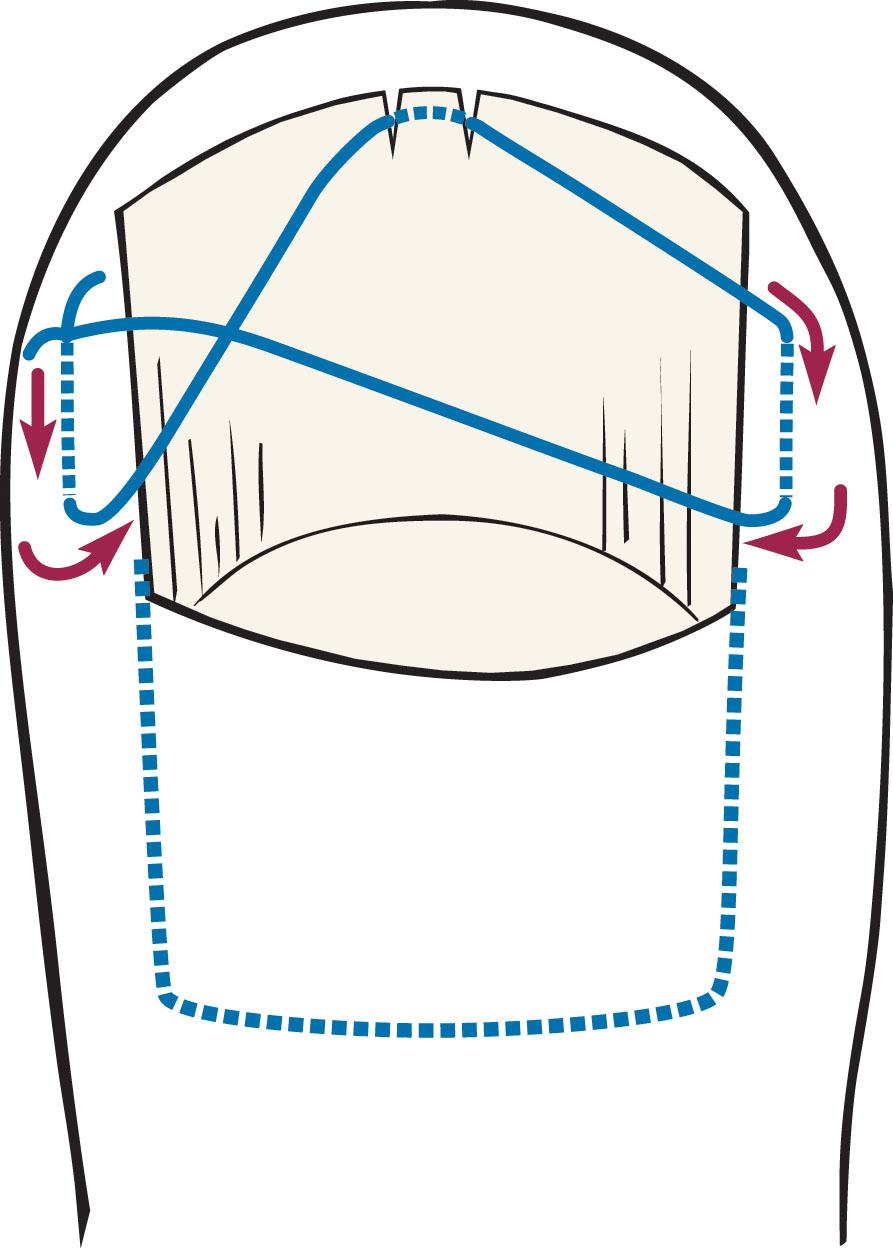
The suture is then tied.
A germinal matrix graft could also be harvested from adjacent nail tissue, and the nail narrowed as in a Winograd procedure ( Fig. 14-9 ) or harvested from another toe. Few studies are available, however, on toenail bed reconstruction. Nonetheless, it makes sense that similar procedures could be used on the toes and the fingers.
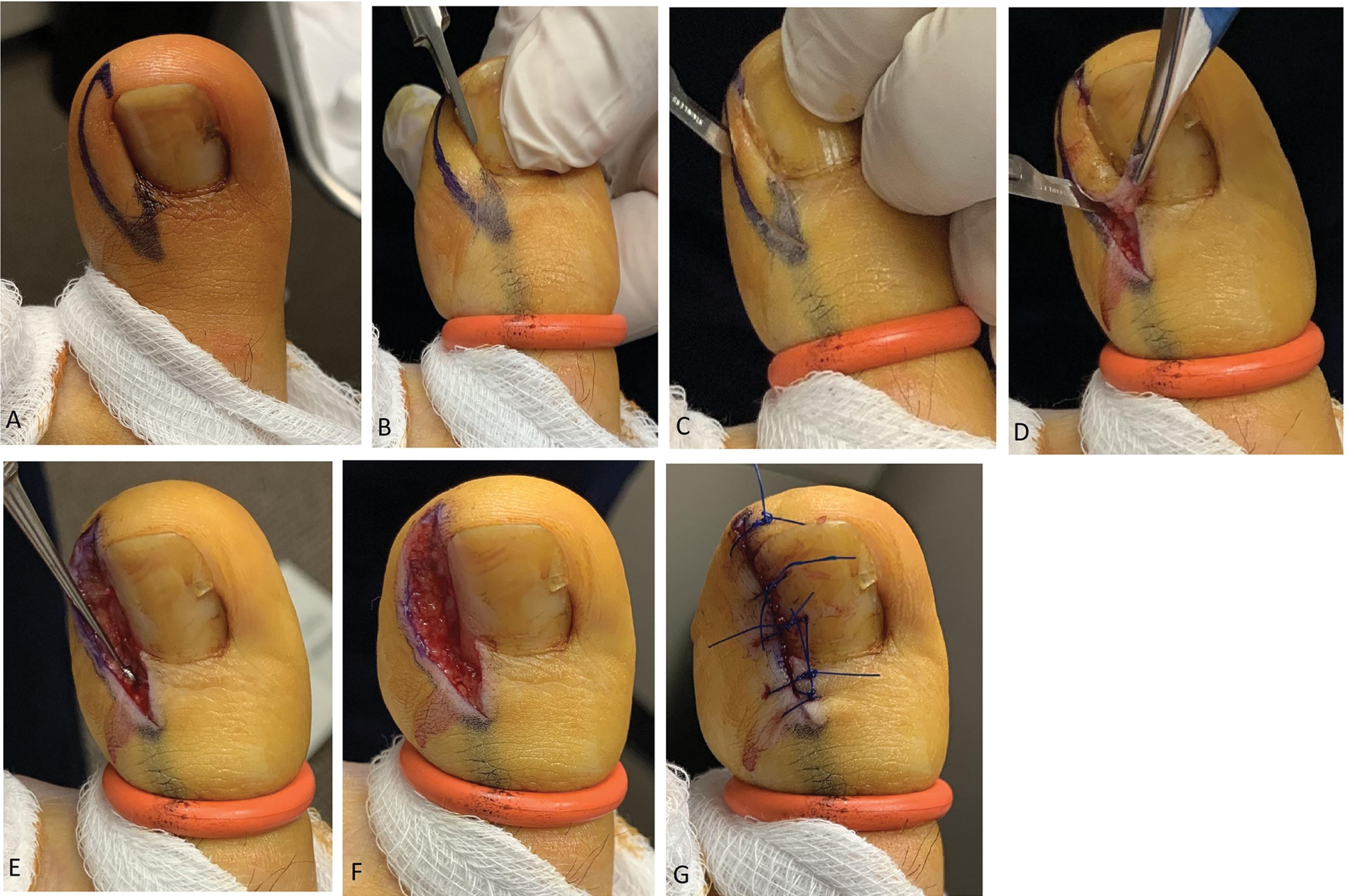
On the medial aspect of the nail plate, with excessive pronation, hypertrophy of the ungualabia can result in an ingrown toenail. Parrinello et al compared the shape of the great toenail with the base of the distal phalanx and found a significant correlation between the shape of the proximal aspect of the nail plate and the shape of the phalangeal base. However, they found no correlation between the shapes of the proximal and distal portions of the nail plate. They concluded that many other factors besides trauma influence the shape of the nail, including constricting footwear, snug-fitting stockings and hosiery, inadequate or inappropriate pedicures, and heritable traits that can lead to incurvation of the nail border, with subsequent inflammation and infection.
Split-nail deformities may be treated surgically with nail removal, elliptic nail bed scar removal, and careful elevation of the matrix off the bone with extension of this dissection laterally until the nail matrix can be closed without tension. Defects in the nail bed from excisional biopsy can be repaired with a free graft from the lesser toes or with split-thickness, sterile matrix grafts from the adjoining nail matrix. Subungual splinters may be removed by sequential thin, sharp filings of the nail until the splinter is exposed along its entire length. This allows complete splinter removal without having to remove the entire nail.
The majority of these injuries occur from closing doors, dropping heavy objects, or hitting the toes on fixed objects. The most common feature will be ecchymosis with or without the presence of lacerations. A dorsal wound at the matrix region may be associated with avulsion of the base of the nail from below the proximal nail fold. This may be associated with fracture of the distal phalanx: transverse fracture of the midportion, comminuted fracture of the distal portion, or separation of the terminal tuft. In skeletally immature patients, the fracture will usually be at the physis of the proximal phalanx.
Avulsion of the nail plate can leave the nail bed open and possibly injured ( Fig. 14-10A ). As the nail bed scars, the surface may become irregular, resulting in a deformed new nail or arrest of new nail regeneration. Wounds into the germinal matrix may result in a longitudinal groove in the nail plate or a split nail. To minimize these possible outcomes, an attempt can be made to keep the proximal fold patent with foil or by placing the injured nail plate back under the proximal fold after fracture irrigation and nail bed repair. If the proximal portion of the germinal matrix under the proximal fold is intact, a tear in the distal germinal matrix will not necessarily prevent regrowth of the nail but may cause deformity with time. Matrix contusions may also lead to loss of nail growth. Hematomas may be evacuated to reduce pain and pressure depending on size.
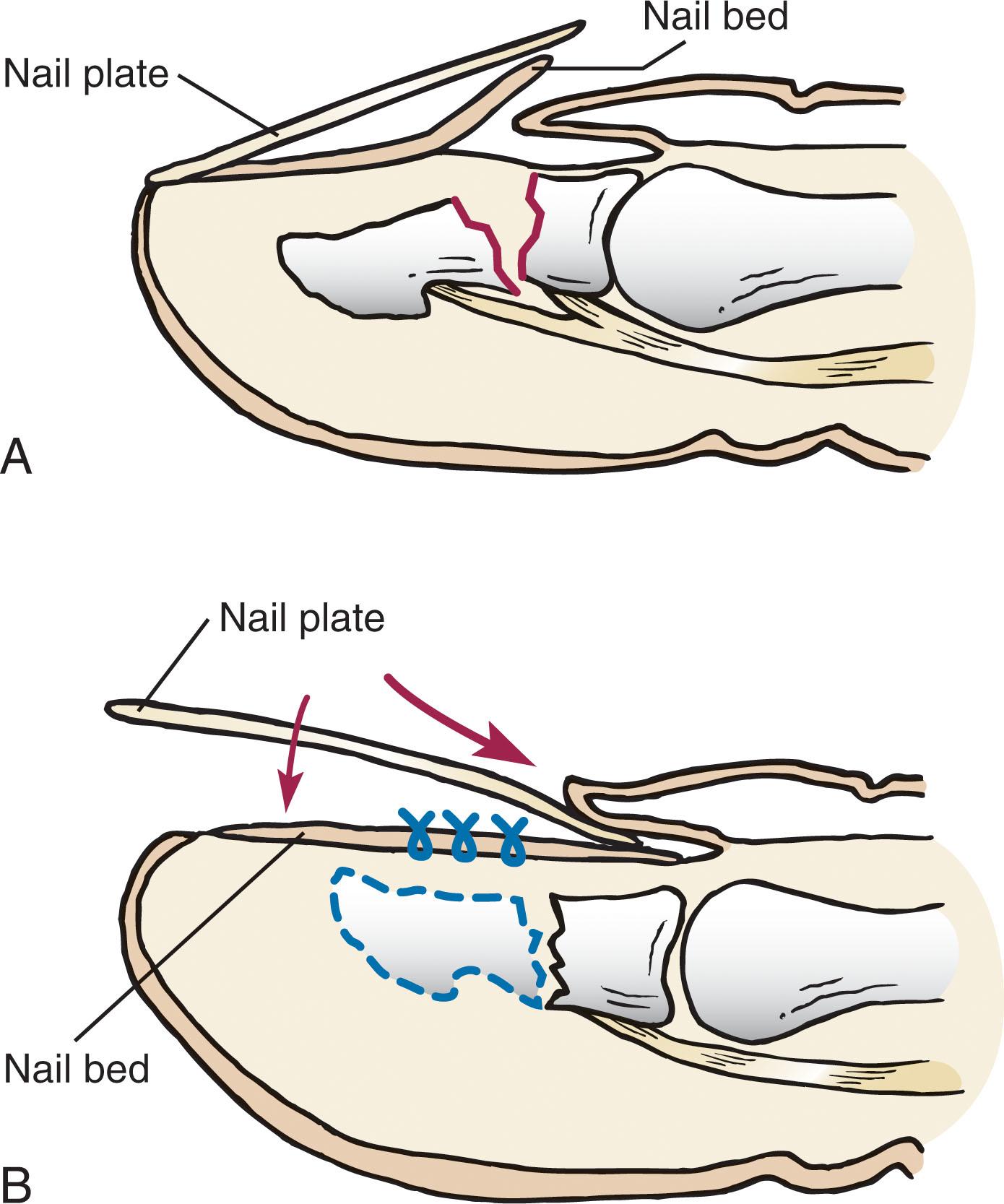
In treating nail crush injuries, devitalized tissues should be excised. For fractures of the terminal phalanx, large bone fragments can be splinted or sutured. The nail often serves as a splint once the soft tissues are repaired. Damage of the matrix and periosteum requires repair with fine (6-0 or smaller) suture ( Fig. 14-10B ).
Splinting with the nail will aid in shaping the new nail and control the scar formation of the matrix and nail bed.
Hemorrhagic accumulation between the nail bed and the nail plate is a subungual hematoma . The differential diagnosis of a discolored nail includes subungual exostosis, malignant melanoma, Kaposi sarcoma, nevus, glomus tumor, and trauma. Typically, subungual hematoma occurs with repetitive, unrecognized, microtrauma to the nail bed and rupture of small capillaries in this region ( Fig. 14-11 and Fig. 14-12A–D ). Less commonly, acute crushing or shearing trauma to the nail produces painful subungual hemorrhage manifested by a dusky swelling of the nail plate. Within hours after injury, pressure builds up because of bleeding beneath the nail plate. Edema, pain with movement of the digit, and blue or black discoloration under the nail can prompt the patient to seek evaluation and treatment.
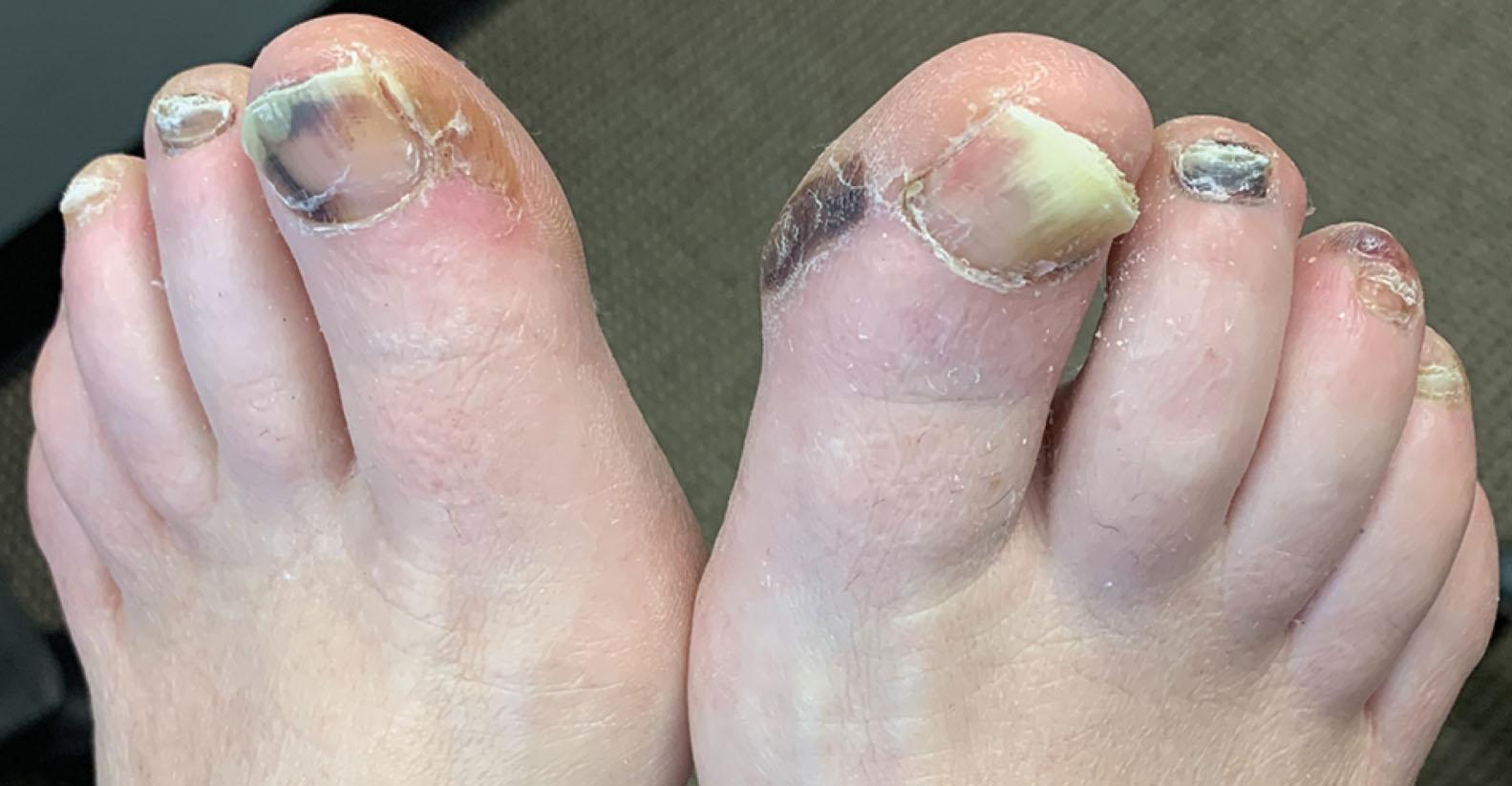

A syringe needle, nail drill, trephine, dental burr, fine-point scalpel blade (No. 11), heated paper clip, or carbon dioxide laser may be used to penetrate the nail bed and evacuate an acute trapped hematoma ( Fig. 14-12E–G ), typically providing immediate relief. Palamarchuk and Kerzner describe using a handheld cautery unit to decompress a subungual hematoma. With minimal pressure on the nail, the cautery unit creates a small hole in the nail, and the hematoma is easily evacuated. Radiographs are frequently necessary to rule out a fracture of the distal phalanx that may be positive in 25% of patients. Further therapy may include oral antibiotics.
Tucker et al studied crush injuries of the distal phalanx with concomitant nail bed injuries. In general, if the hematoma was less than 20% of the area of the nail plate, patients were not treated. Some hand surgeons suggest that less than 50% hematoma for fingernails can be neglected. A larger area of hematoma suggests the possibility of a nail bed injury and possible fracture of the distal phalanx. With an open injury, inspection of the nail bed and repair of a lacerated nail bed or matrix may be necessary. An open fracture should be treated routinely like any open fracture. Fox reported a case of osteomyelitis after an open nail bed injury and recommended aggressive irrigation and debridement and parenteral antibiotics to minimize the risk of subsequent infection.
Tumors of the soft tissue adjacent to the toenails or involving the nail unit itself can be benign or malignant ( Table 14-12 ). Periungual and subungual warts (verrucae) are common soft tissue growths ( Fig. 14-13 ). Fibromas and fibrokeratomas can result from trauma to the toes, with consequent nodule formation impinging on the nail plate. These benign connective tissue lesions can also develop beneath the nail plate itself and cause elevation and deformity. Pressure on the nail matrix can create a longitudinal defect in the nail plate as well. A periungual fibroma or angiofibroma (see Fig. 14-13F ) may be the first evidence of tuberous sclerosis or ectodermal dysplasia. In general, fibromas respond readily to excision or cauterization. Glomus tumors, pyogenic granulomas, and keratoacanthomas must all be considered in the differential diagnosis.
| Benign Nail Tumors | Malignant Nail Tumors | Bone Tumors |
|---|---|---|
|
|
|
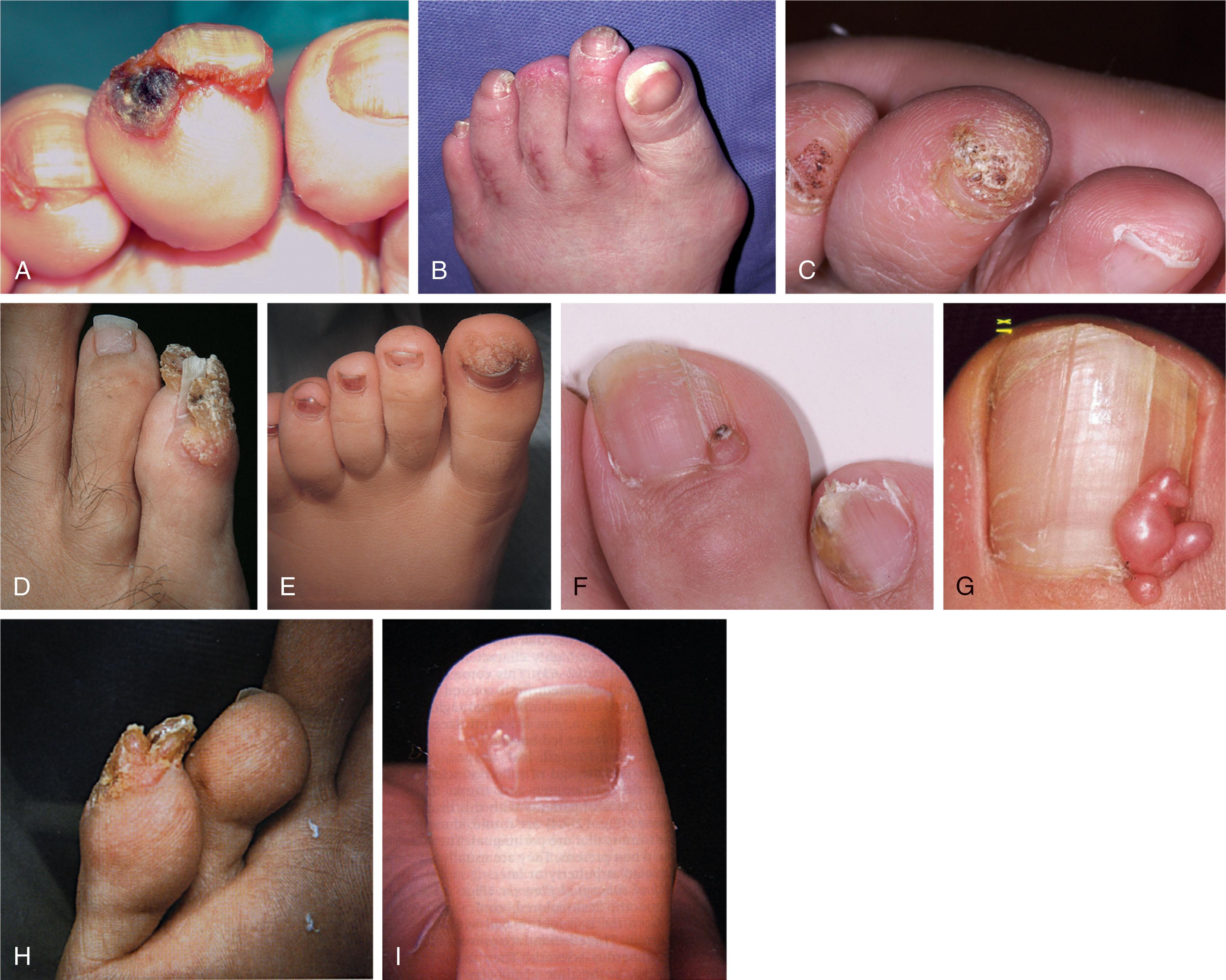
A glomus tumor is most commonly encountered on the acral portions of the extremities. This lesion is often in the subungual area and consists of a reddish purple nodule measuring only a few millimeters in diameter. It is tender and gives rise to severe paroxysmal pain. Glomus tumors rarely ulcerate or bleed, and excision usually results in a cure, although subungual lesions are more difficult to eradicate. They are almost universally benign; however, because of symptoms and malignant potential, diagnosis and treatment is essential. The differential diagnosis includes melanoblastoma, melanoma, neuroma, chronic perionychium, gout, arthritis, foreign body granuloma, and Kaposi sarcoma.
The glomus tumor appears to be a cutaneous arteriovenous anastomosis arising from a highly vascular compilation of epithelioid cells and glomus cells known as a glomus body. This thermoregulatory structure, found densely within the fingers and toes, is responsible for temperature, vascular regulation, and sensation; hence it tends to give the patient cold insensitivity.
The only effective treatment for a glomus tumor is complete surgical excision. Excision with negative margins results in adequate diagnosis and treatment. If malignant features are present, wide excision is needed, with close follow-up for development of metastasis. Previously, it was necessary to remove the nail, incise the nail matrix, remove the tumor, and repair the nail bed. A study of seven cases, however, demonstrated that creating an L-shaped incision, 5 mm distal and 5 mm medial or lateral to the nail, and lifting off the entire vascular flap allowed removal of the tumor (see Fig. 14-14A–C ). The flap was then sutured back to its origin after hemostasis. There were no recurrences or nail irregularities. This technique might lend itself to other subungual operations as well, such as treatment of subungual exostosis. This approach has been used by others and is recommended for all noninvasive space-occupying subungual lesions, regardless of type. Radiographs or computed tomography (CT) scans may show small cortical abnormalities in the distal phalanx. T2-weighted magnetic resonance imaging (MRI) may be used to determine the precise location of the tumor and may show a well-circumscribed highly vascular mass (see Fig. 14-14D and E ). Pahwa described a “trap door” technique used for glomus tumor excision in which medial and lateral slits were cut in the proximal nail fold in line with the gutters. The distal plate is then carefully freed from the underlying bed and elevated from it distally, with the proximal plate and proximal fold acting as a hinge. The tumor can then be excised and then the nail plate and nail fold sutured back into position.
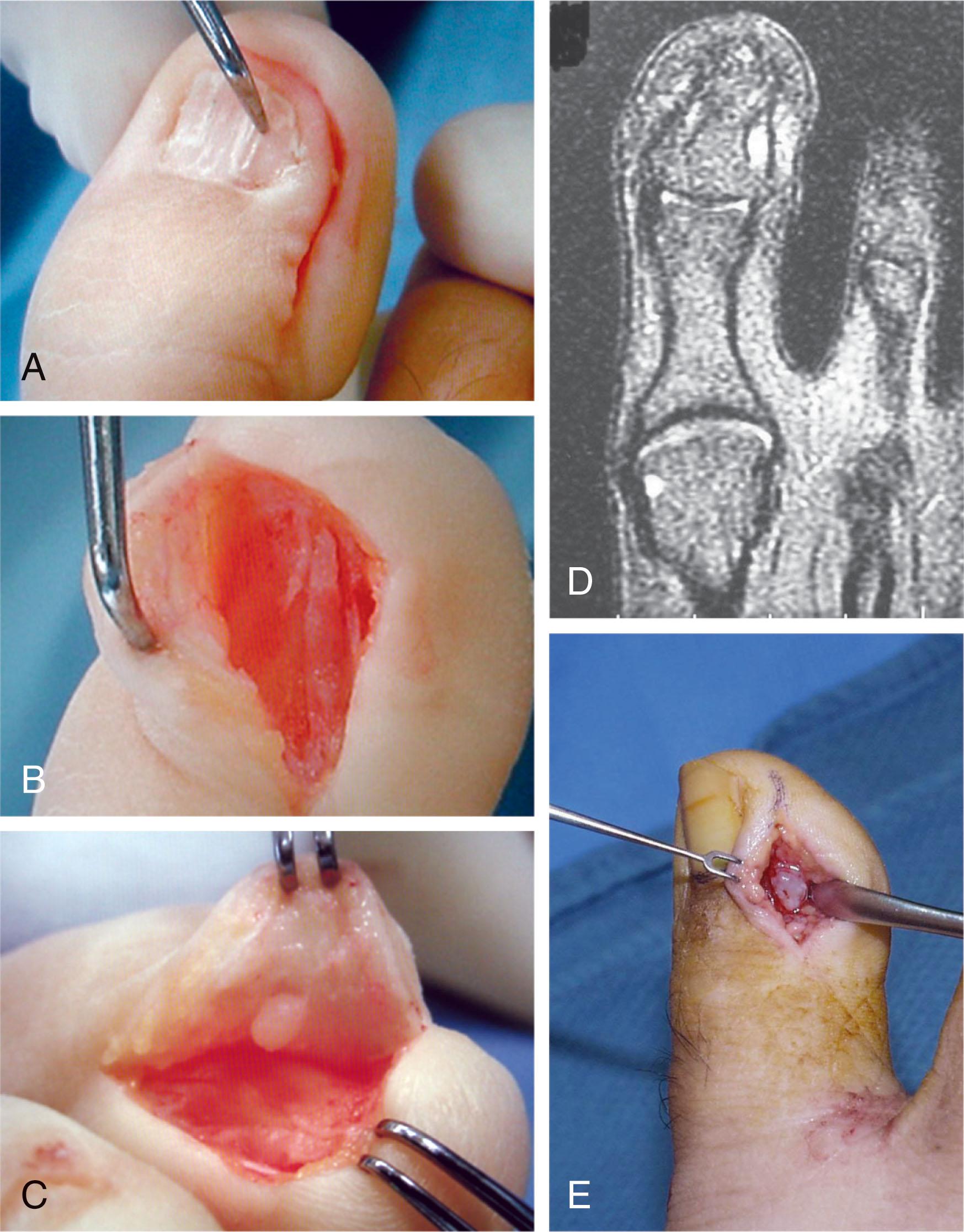
Another type of glomus tumor, which is different histologically and is characterized by multiple painless hemangiomas, often has an autosomal dominant familial pattern. These multiple lesions are usually asymptomatic.
A subungual exostosis is a benign bony growth typically occurring on the dorsomedial aspect of the distal phalanx tuft ( Fig. 14-15A–D ). Originally described by Dupuytren in 1817, subungual exostosis has a predilection for the hallux, although occasionally it develops in the lesser toes. A subungual exostosis typically has a moderate growth rate, resulting in growth that rarely exceeds 0.5 cm.
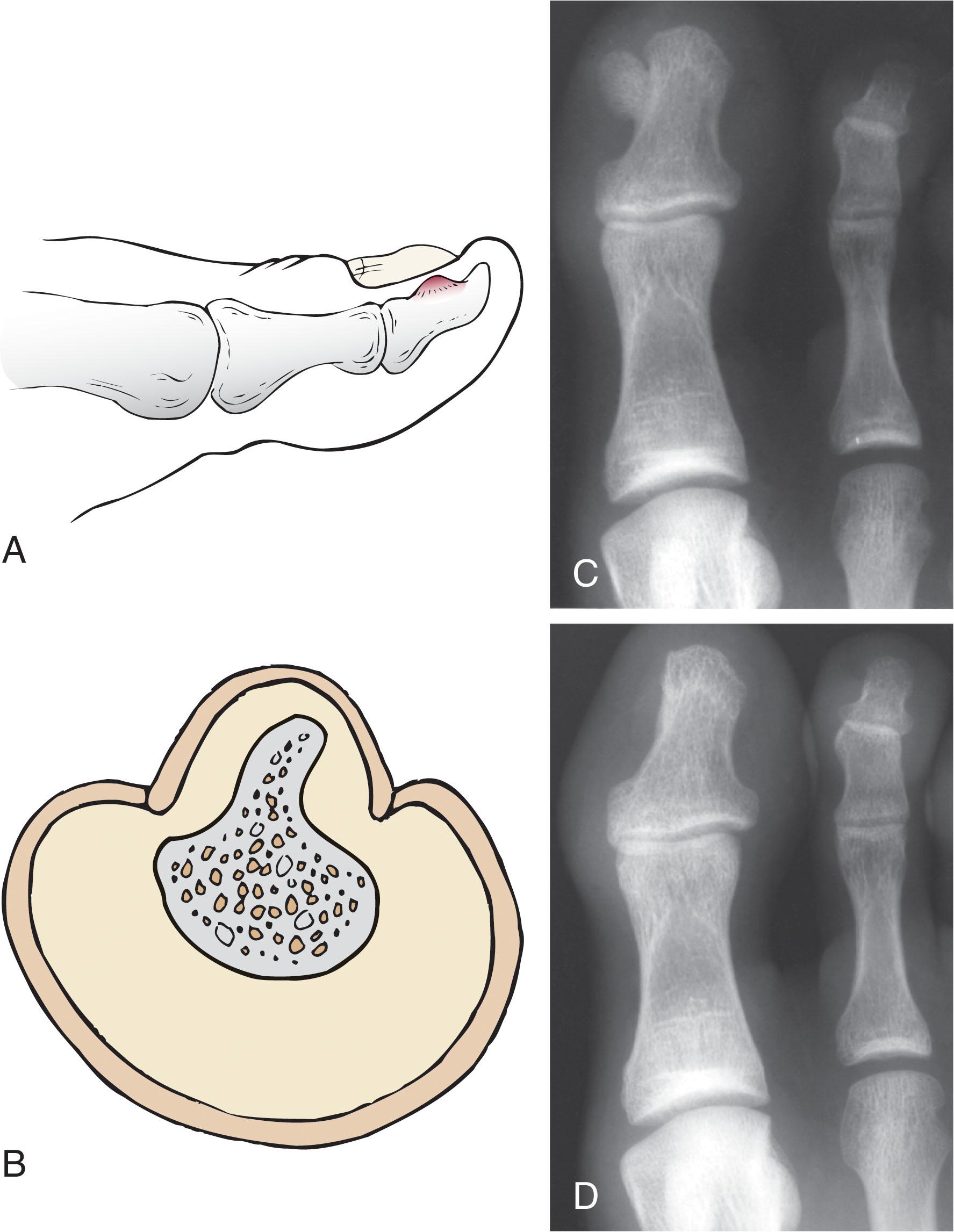
The cause of subungual exostosis is thought to be traumatic, infectious, or from chronic irritation. Fikry et al found a history of trauma or repetitive microtrauma in 21 of 28 cases of exostosis. Reporting on 21 cases of subungual exostosis, Ippolito et al noted that 12 patients were athletes involved in activities such as dancing, gymnastics, or football. It is believed that increased pressure against the dorsal aspect of the nail plate from a constricting toe box can cause irritation that leads to the development of a subungual exostosis. The connection between a specific traumatic incident and the subsequent development of a subungual exostosis can also explain the increased incidence of this abnormality in athletes. Many patients describe pain that is aggravated by activities such as running or walking and is most likely from the pressure of an expanding lesion against the toe box.
Osteochondroma, on the other hand, is a congenital condition, although the patient may recall a traumatic event that brings a formally asymptomatic lesion to their attention. Vazquez-Flores et al noted in a review of 27 cases of subungual osteochondroma, trauma was recalled by 40.7% of the patients.
Osteochondroma characteristically occurs on the dorsal aspect of the phalanx in a juxtaepiphyseal region, whereas exostosis may be closer to the tip of the phalanx ( Table 14-13 ). Osteochondroma occurs more often in adolescent boys than girls (2 : 1 ratio). In contrast, subungual exostosis is seen more commonly in young adults aged 20 to 40 years. Ippolito et al found that subungual exostoses occurred more often in the female population (2 : 1 ratio), whereas Miller-Breslow and Dorfman reported an equal distribution between male and female patients. Gotkay et al found no age or sex difference between osteochondroma and subungual exostosis in a series of 25 cases.
| Condition | Typical Age at Diagnosis (Years) | Male-to-Female Ratio | Cause | Growth Rate | Histopathology | Site | Risk of Malignancy |
|---|---|---|---|---|---|---|---|
| Exostosis | 20–40 | 1 : 2 | Traumatic | Moderate | Fibrocartilage | Tuft | Not reported |
| Osteochondroma | 10–25 | 2 : 1 | Congenital | Slow | Hyaline cartilage | Juxtaepiphyseal | Low |
The histologic characterization of the cartilage cap is diagnostic when distinguishing between subungual exostosis and subungual osteochondroma. In a subungual osteochondroma, a hyaline cartilage cap overlies a trabeculated bony pattern. However, subungual exostosis has a fibrocartilaginous cap that is a reactive fibrous growth with cartilage metaplasia. Jahss noted that a subungual exostosis is characterized histologically as chronic fibrosis caused by irritation. A trabecular bony pattern connecting with the distal phalanx can underlie the fibrocartilaginous cap.
A subungual exostosis can be misdiagnosed or confused with other toenail abnormalities. Elevation of the nail plate ( Fig. 14-16A ) and discoloration can resemble chronic onychomycosis or a subungual hematoma. Chinn and Jenkin reported two cases of patients with pain in the proximal nail groove who had undergone an unsuccessful surgical matrixectomy and who later received a diagnosis of subungual exostosis. The differential diagnosis includes subungual verruca, pyogenic granuloma, glomus tumor, keratoacanthoma, subungual nevus, and epidermoid inclusion cyst as well as malignant lesions, such as carcinoma of the nail bed and subungual melanoma.
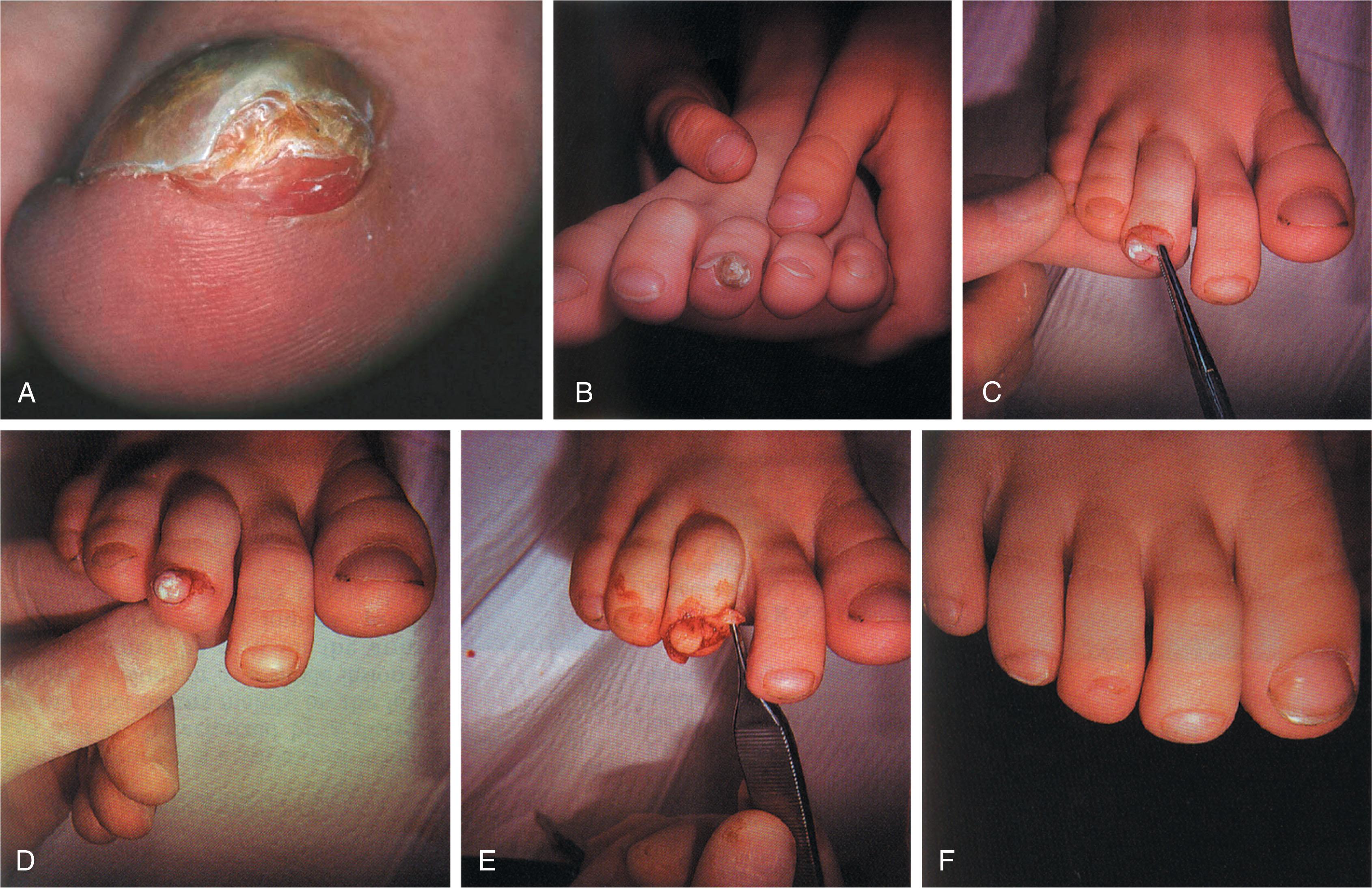
The diagnosis is supported by radiographic evidence of the lesion that may be seen best on a lateral or oblique radiograph. An exostosis typically appears as an exophytic bony mass on the dorsomedial tip of the distal phalanx. The lesion may appear to be growing distally away from the physis. The base is pedunculated or sessile but the tip is flattened, cupped, or dome shaped.
An osteochondroma appears as a sessile or pedunculated expansion of trabecular bone from the juxtaepiphyseal region of the distal phalanx. The base may be sessile, pedunculated, or circumscribed. The hyaline cartilage cap is not visible unless it becomes calcified. Although the lesion may be quite large, the radiographic appearance may be smaller than its actual size.
De Palma et al reported on 11 cases of surgical excision of a subungual bony masses with partial onychectomy. Using histochemical and immunohistochemical methods, they concluded that most subungual lesions exhibited the characteristics of conventional osteochondromas and that the distance of the lesion from the epiphyseal line was unrelated to its histologic features ( Fig. 14-16B–F ).
Although a small asymptomatic lesion may be observed and treated conservatively, surgical resection of a subungual exostosis or subungual osteochondroma is the most common treatment of a symptomatic lesion. The operation involves either the above-described procedure for glomus tumor (see Fig. 14-14A–C ) or the following procedure ( Fig. 14-17A–D ). A defect remaining in the nail bed after surgical excision may heal by secondary intention ( Fig. 14-18A–G ). However, some authors have used artificial collagen matrix substitute dermis with success.
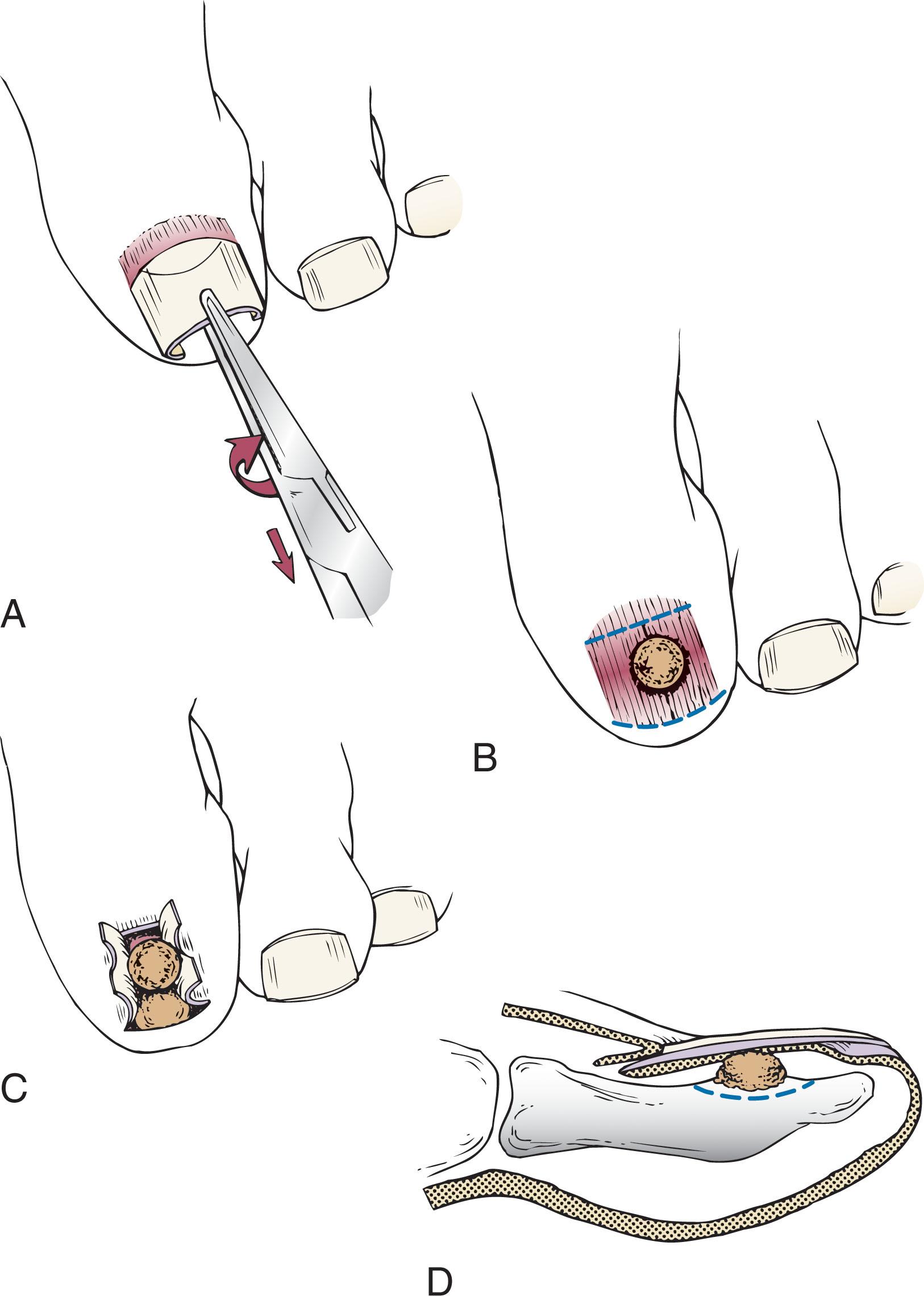
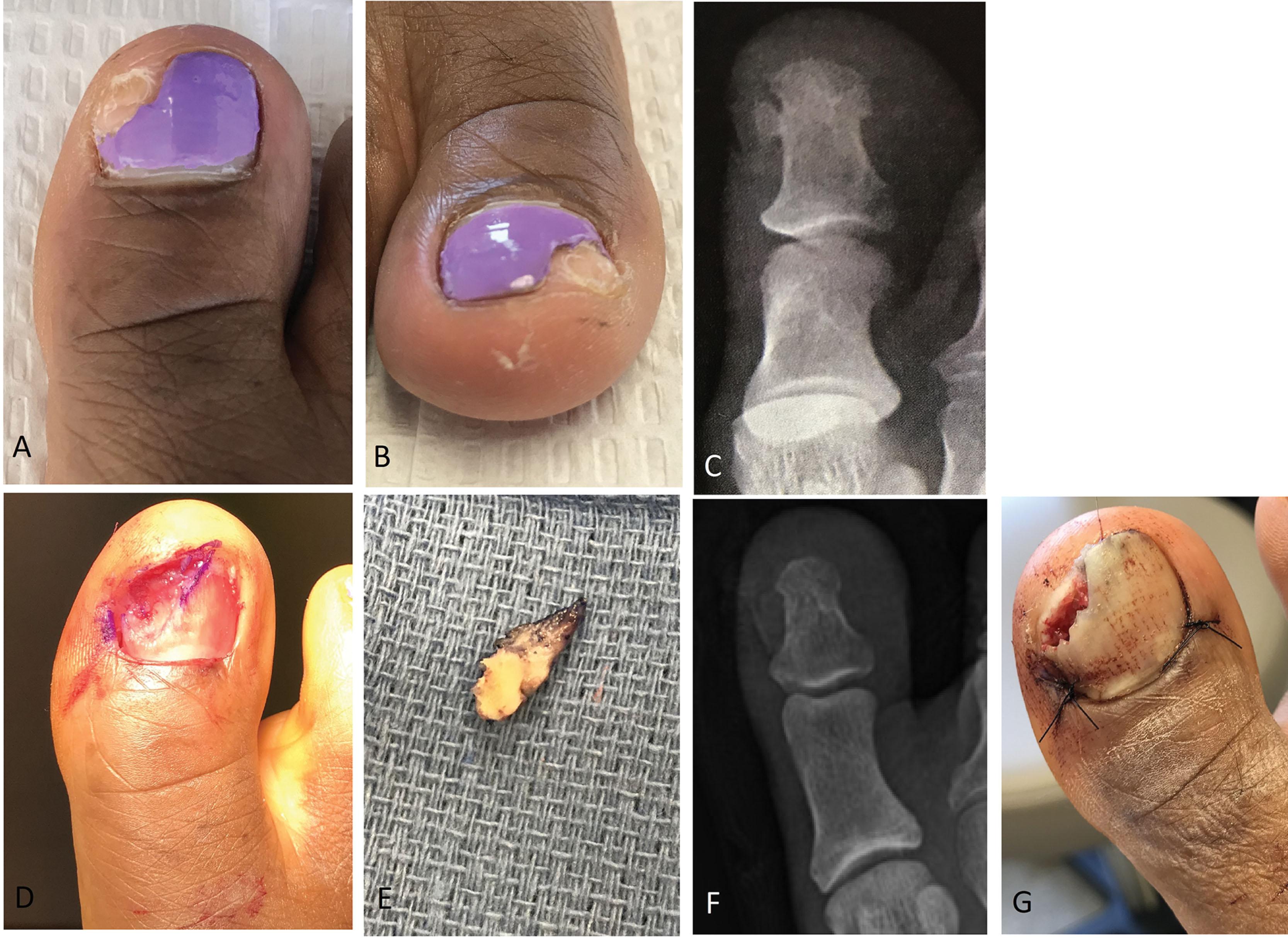
A digital anesthetic block is administered and a 0.25-inch Penrose drain or a commercially available digital tourniquet is applied.
A partial or complete toenail avulsion is performed.
A longitudinal incision is made in the nail bed. The nail bed is reflected off the exostosis, with care to avoid damage to the nail matrix.
The exostosis is resected with an osteotome or bone cutter. The base of the lesion is curetted.
The nail bed is relocated and closed with suture.
A compression dressing is applied and changed 24 hours postoperatively. Dressing changes are continued until drainage subsides. The nail bed is protected with a plastic bandage strip until tenderness resolves.
A systematic review of surgical treatment for subungual exostoses found 13 articles with over 10 cases each. Fifty-five percent of patients were younger than 18, and only 30% had a history of trauma. Most patients underwent excision with a fish-mouth incision of the distal tuft. Onychodystrophy occurred in 10% of cases. The authors suggest there is weak evidence to recommend a nail bed sparing technique to minimize the risk of onychodystrophy.
An exostosis recurs infrequently but can develop after an incomplete resection. Recurrence may be a continuing source of irritation to the toenail. Miller-Breslow and Dorfman reported a 53% incidence of recurrence when a subtotal excisional biopsy was performed. After wide local excision with curettage of the base, however, a 5% to 6% rate of recurrence is expected.
These malignant tumors are more common on the fingers than on the toes. Aulicino and Hunter reported on 72 cases of subungual melanoma, of which two thirds were on the thumb or great toe. Hutchinson published the first significant report on subungual melanoma in 1886. Koenig and McLaughlin stated that 0.025% of all reported cancer is caused by subungual melanoma. Melanomas that involve the nails are termed melanotic whitlows . Blackish discoloration develops, especially in the nail bed ( Fig. 14-19A ), but minimal pigmentation or the absence of pigment does not exclude the diagnosis of melanoma. The Hutchinson sign (pigment spreading beyond the nail plate into the proximal or lateral nail folds, or both) is considered pathognomonic of subungual melanoma ( Fig. 14-19B ) and may be related to treatment decisions and outcome.
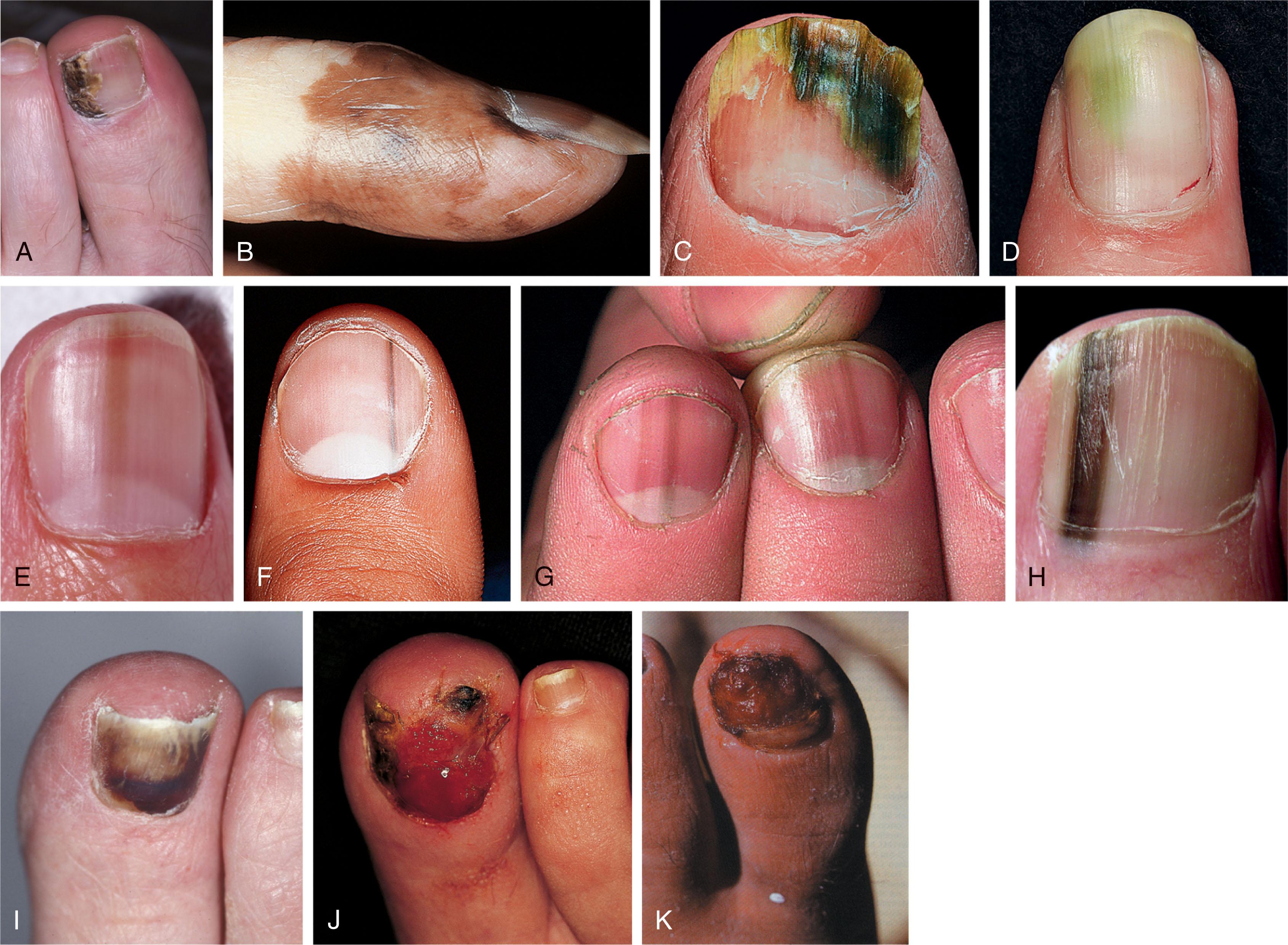
Twenty-three percent of melanomas involving the nail may be amelanotic. Other reported colors include tan, brown, and blue. A greenish tinge to the nail is most likely due to a Pseudomonas infection ( Fig. 14-19C and D ).
On physical examination, a melanoma may be accompanied by a splitting or loss of the nail, ulceration, and localized erythema. The most common cause of darkening of the nails is trauma, but other causes include Addison disease and Peutz-Jeghers syndrome. The differential diagnosis of malignant melanoma also includes glomus tumor, benign nevus, paronychia, onychomycosis, pyogenic granuloma, linear melanonychia ( Fig. 14-19E–G ), and onychomycosis.
Often malignant melanoma is misdiagnosed as a benign condition, which can lead to long delays in diagnosis and appropriate treatment. With malignant melanoma, unlike a benign condition such as subungual hematoma ( Fig. 14-19H and I ), discoloration of the nail does not change as the nail grows distally and does not improve with time. A malignant melanoma might not damage the overlying nail plate, whereas a subungual hematoma can cause plate elevation. Typically, a malignant melanoma is deep black, in contrast to the less distinct color of a subungual hemorrhage. Patients are often advised to observe whether or not the pigmented area migrates distally with the growing nail plate. The patient's anxiety can be reduced with a simple and quick method of blood detection under the nail. Small scrapings of the discolored nail are obtained under the distal free edge of the nail plate. The nail plate fragments are placed on a urinalysis reagent strip (Hemostix; Bayer Medical, Newbury, United Kingdom). A drop of water is added to soak the fragments and strip. Within 1 minute, a green color may indicate blood and the likelihood of subungual hemorrhage rather than melanoma.
Many patients with a subungual melanoma report the occurrence of trauma, which makes an early diagnosis difficult. Approximately 4% occur in the foot, and two thirds of these appear on the hallux. Melanoma occurs more often in female patients and in white patients and has an incidence of 10% to 31% among nonwhite patients. The typical age at presentation is 50 to 60 years. A poor prognosis is associated with lymph node involvement and nail destruction or ulceration, and the long-term survival rate varies from 18% to 40%. Because the lesion is often mimicked by other conditions, it is most important to do an excisional biopsy for any suspicious lesion (such as a nonhealing ulcer, subungual discoloration, or subungual hematoma) that does not advance with the nail ( Fig. 14-19J and K ).
Pack and Oropeza and Papachristou and Fortner reported that one third of patients initially present with regional lymph node involvement and that biopsy should be done for any suspicious lesion. Early amputation is the treatment of choice, usually at the metacarpophalangeal joint, because resections more than 3 cm from the lesion are not of clinical value even for the thickest melanomas. However, studies of the hand suggest that a more functional, distal removal of the affected tissue can be equally effective in some situations.
Bowen disease is a relatively rare premalignant dermatologic disorder originally described by Bowen in 1912. It is typically a well-circumscribed, erythematous, papular, nodular, crusting lesion that can be mistaken for psoriasis ( Fig. 14-20C ). Bowen disease is described as a variant of squamous cell carcinoma, an in situ carcinoma that does not usually metastasize. Patients with Bowen disease are more likely to develop other primary malignancies, and Graham and Helwig, reporting on 35 cases, noted that 80% of patients died of primary malignancies within 9 years after the appearance of Bowen disease. Lemont and Haas reported that peak occurrence is in the eighth decade, typically on the plantar aspect of the foot. Surgical excision or curettage is the treatment of choice. If the basement membrane is disrupted, however, the potential exists for distant metastases. When maximal tissue must be preserved, Mohs surgery is 90% effective, and when there is no osseous involvement, Mohs surgery is considered the treatment of choice. The key is to perform a biopsy of any chronic lesion involving the nail.
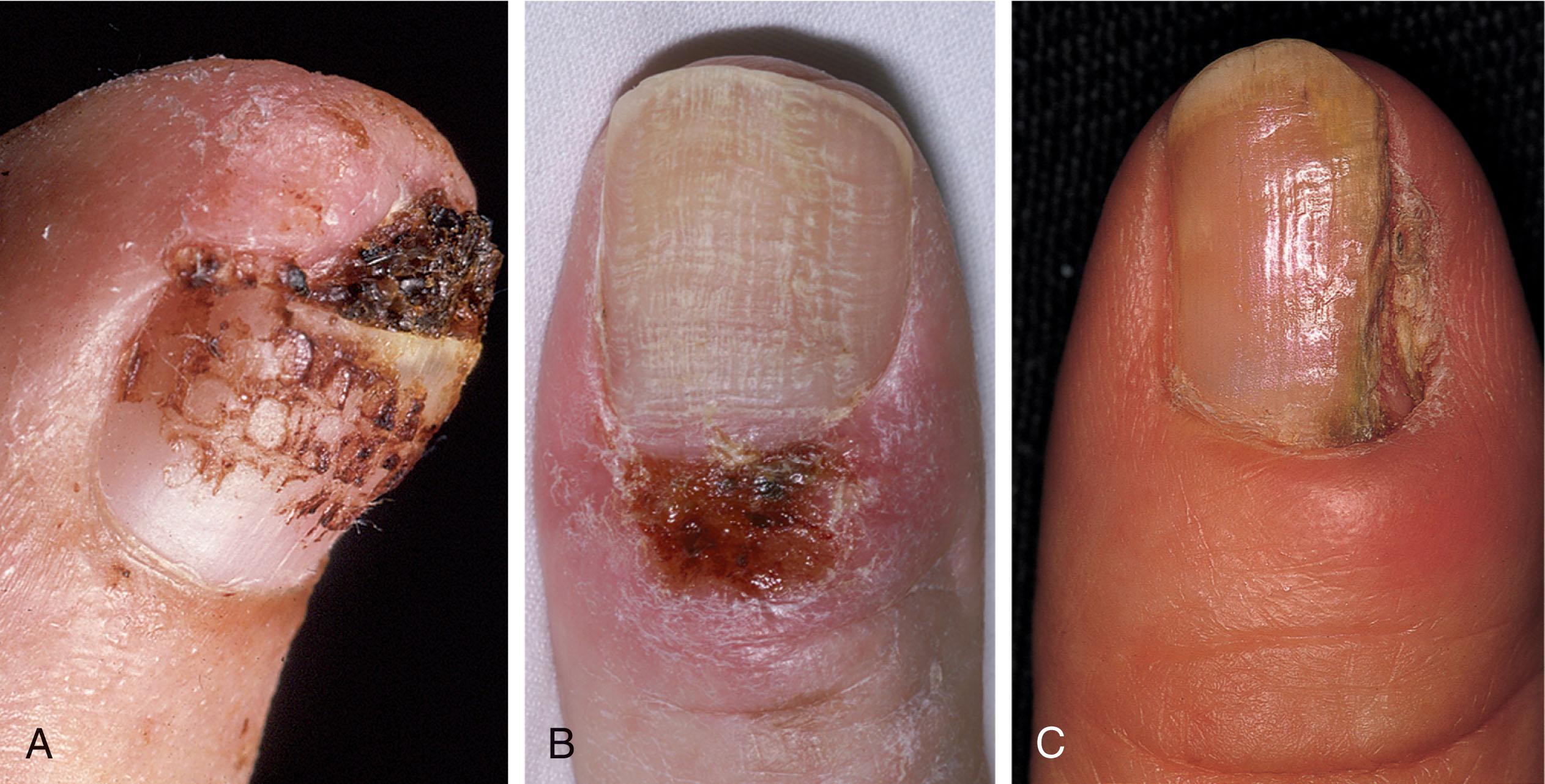
Basal cell carcinoma is rare in the foot, and squamous cell carcinoma ( Fig. 14-20A and B ), Kaposi sarcoma, and other metastatic diseases are relatively rare malignant lesions. Patients with abnormal radiographic findings, chronic pain, swelling, inflammation, infection, or persistent splitting of the nail plate should be evaluated for an underlying tumor of the distal phalanx. A specific diagnosis is essential. After the diagnosis of a malignant tumor has been made by biopsy, amputation of the digit is the typical treatment.
Biopsies of suspicious lesions are important. With the nail removed, the recommendation is to take longitudinal biopsy specimens from the nail bed and transverse biopsy specimens from the nail matrix, with subsequent repair if possible.
Onychopathies and other abnormalities of the toenails are most easily discussed by dividing them into abnormalities of the nail plate, nail bed, nail fold, and nail matrix (see Table 14-3 and Table 14-14 ). Congenital and genetic nail disorders, traumatic nail disorders, tumors, and dermatologic and systemic nail disorders are discussed elsewhere in this chapter.
| External Pressure | Internal Pressure | Systemic Conditions |
|---|---|---|
|
|
|
Onychocryptosis, onychauxis, onychogryphosis, onychomycosis, onychia, onycholysis, and onychomadesis are the nail plate disorders seen most often.
Onychocryptosis occurs when the border of the nail plate penetrates the adjacent soft tissue of the nail fold ( Fig. 14-21 ). Synonyms for this condition include “ingrown toenail,” “unguis incarnatus,” and “ungualabial hypertrophy.” The differential diagnosis includes trauma, paronychia, subungual exostosis, onycholysis, and onychophosis. The term “ingrown toenail” is misleading because it implies that the side of the nail plate grows laterally and extends farther into the nail groove. All evidence indicates that the germinal matrix determines the width and growth of the nail. There is no evidence that the matrix becomes wider in a person with an ingrown toenail. The incorrect assumption was that ingrown toenails were caused by an increasing width in the convexity of the nail. Thus initial attempts by surgeons at treating this disease were aimed at narrowing the nail margin. Frost described three types of ingrown toenails: a normal nail plate that, with improper nail trimming, develops a fishhook-shaped spur in the lateral nail groove ( Fig. 14-22A and B ); an inward distortion of one or both of the lateral margins of the nail plate (incurved nail) ( Fig. 14-22C ); and a normal nail plate with soft tissue hypertrophy of the lateral border ( Fig. 14-23 ).
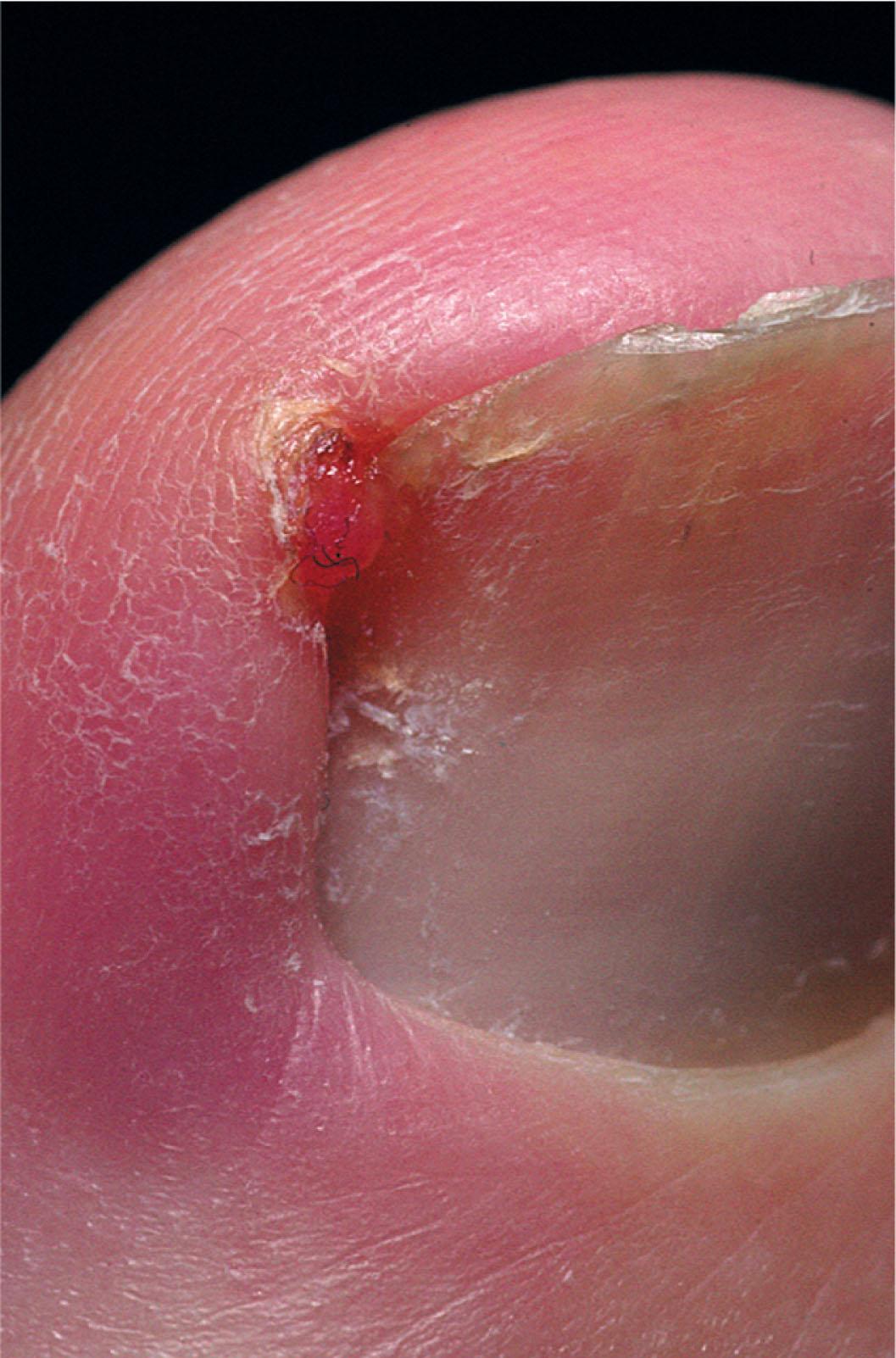
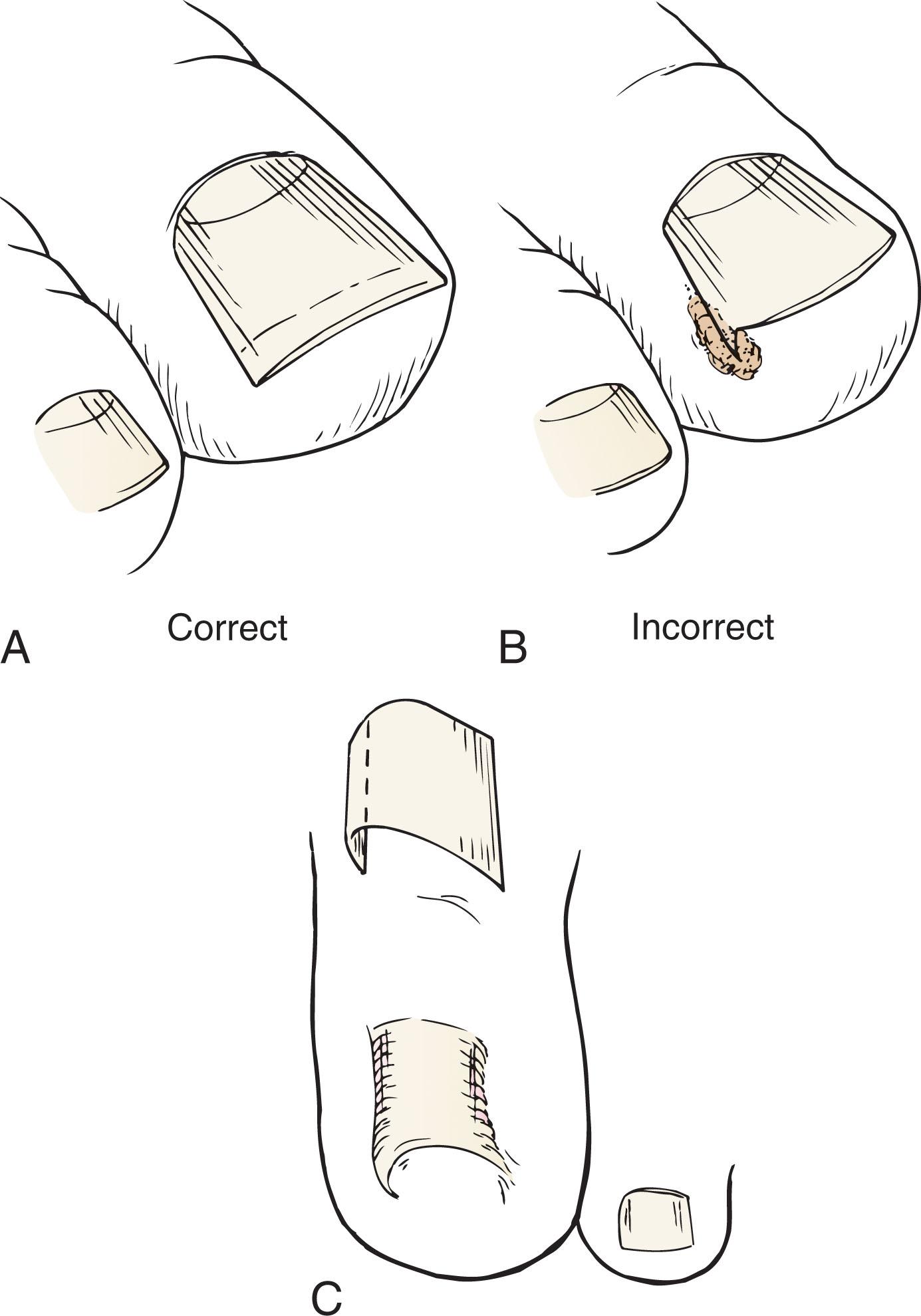
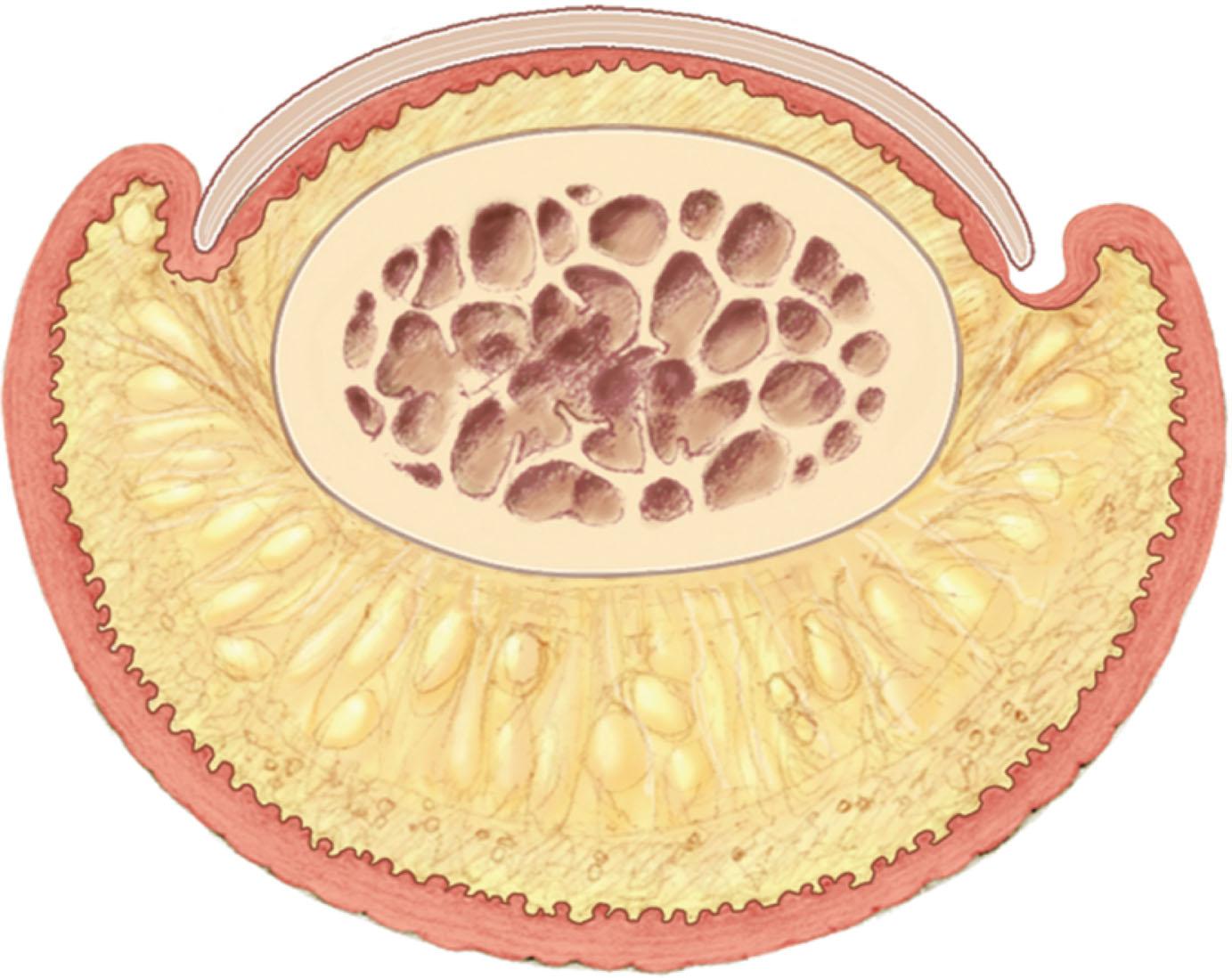
Lloyd-Davies and Brill stated that complete avulsion of the nail plate, which in the past was a common treatment for an ingrown toenail, probably leads to hypertrophy of the distal lip of the nail and causes the entire nail to become embedded and clubbed. If the nail of the great toe is removed, the new toenail, unlike a fingernail, often becomes deformed as it grows distally because of upward pressure placed on it during weight bearing. Elliptically excising the distal soft tissue can reduce this phenomenon ( Fig. 14-24A–C ). Some authors have advocated excising a small portion of the dorsal distal phalanx through this same incision when treating recalcitrant ingrown toenail. A similar crescent incision on the lateral side of the toe has been described to relieve pressure of the nail plate on the lateral nail fold for ingrown toenails ( Fig. 14-24D and E ).
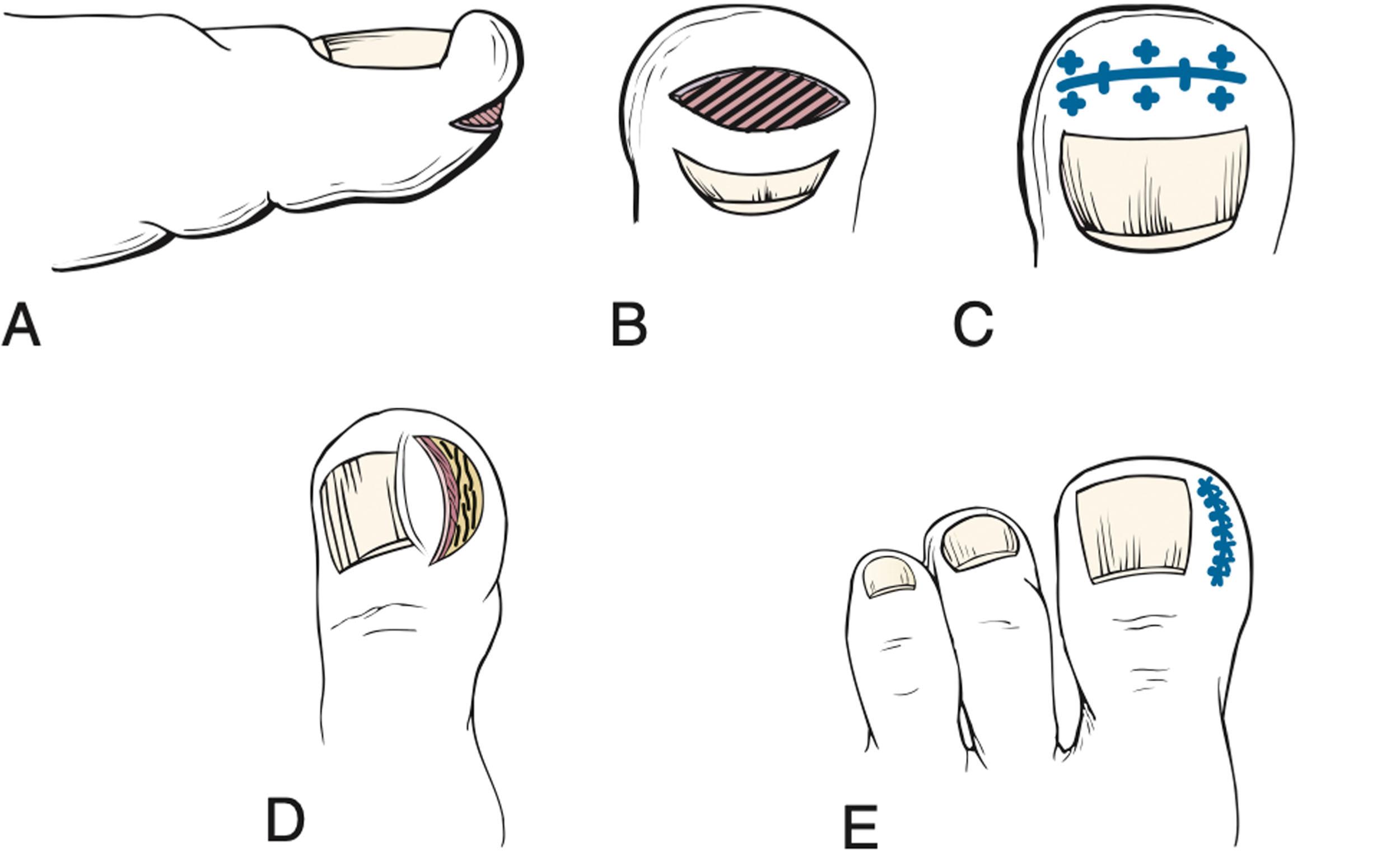
The main conditions that produce symptoms of onychocryptosis are primary hyperplasia of the nail groove in approximately 75% of cases and a deformity of the nail plate in 25% of cases. The latter is caused by an osseous malformation of the dorsum of the distal phalanx or by hypertrophy and irregular thickening of the nail bed, often as a result of a tinea infection. The normal nail plate and its bed are 2 to 3 mm thick. The contour is largely determined by the dorsal shape of the distal phalanx. The shape and contour of the nail can vary widely because of secondary changes in the distal phalanx from irritation and pressure. Such variations often produce nail deformities and accompanying symptoms that can all be classified as ingrown toenail. The most common type is incurvation of the nail margin.
Normally, the space between the nail margin and the nail groove is approximately 1 mm. The groove is lined with a thin layer of epithelium that lies immediately beneath and beside the nail margins. Under normal conditions, this space sufficiently protects the groove from irritation. With a narrow toe box or tight-fitting stockings, downward pressure can develop on the nail plate, the nail lip, or the lateral nail fold. This pressure obliterates the space between the nail plate margin and the nail groove and produces constant irritation. The reactive swelling in the groove leads to gradual hyperplasia of the adjacent soft tissue and ultimately to permanent hypertrophy. As this process continues, the nail groove is finally incised by the nail margin, often with ensuing secondary infection.
To temporarily relieve the acute symptoms, after using local anesthesia or a digital block, the longitudinal border of the nail may be excised ( Fig. 14-25 ). A cotton packing beneath the advancing edge may elevate the nail and alleviate pressure from the nail plate. Merely excising a triangular section of the nail margin may often lead to development of a thick fishhook-shaped deformity of the lateral nail plate that will hook and drag through the nail fold as the nail grows ( Fig. 14-26 ). However, with longitudinal or triangular excision, hypertrophy of the adjacent soft tissue can fill the space of the excised nail margin. As the nail continues to grow distally, it impinges on the elevated nail groove and gives rise to recurrent episodes of infection and formation of granulation tissue.
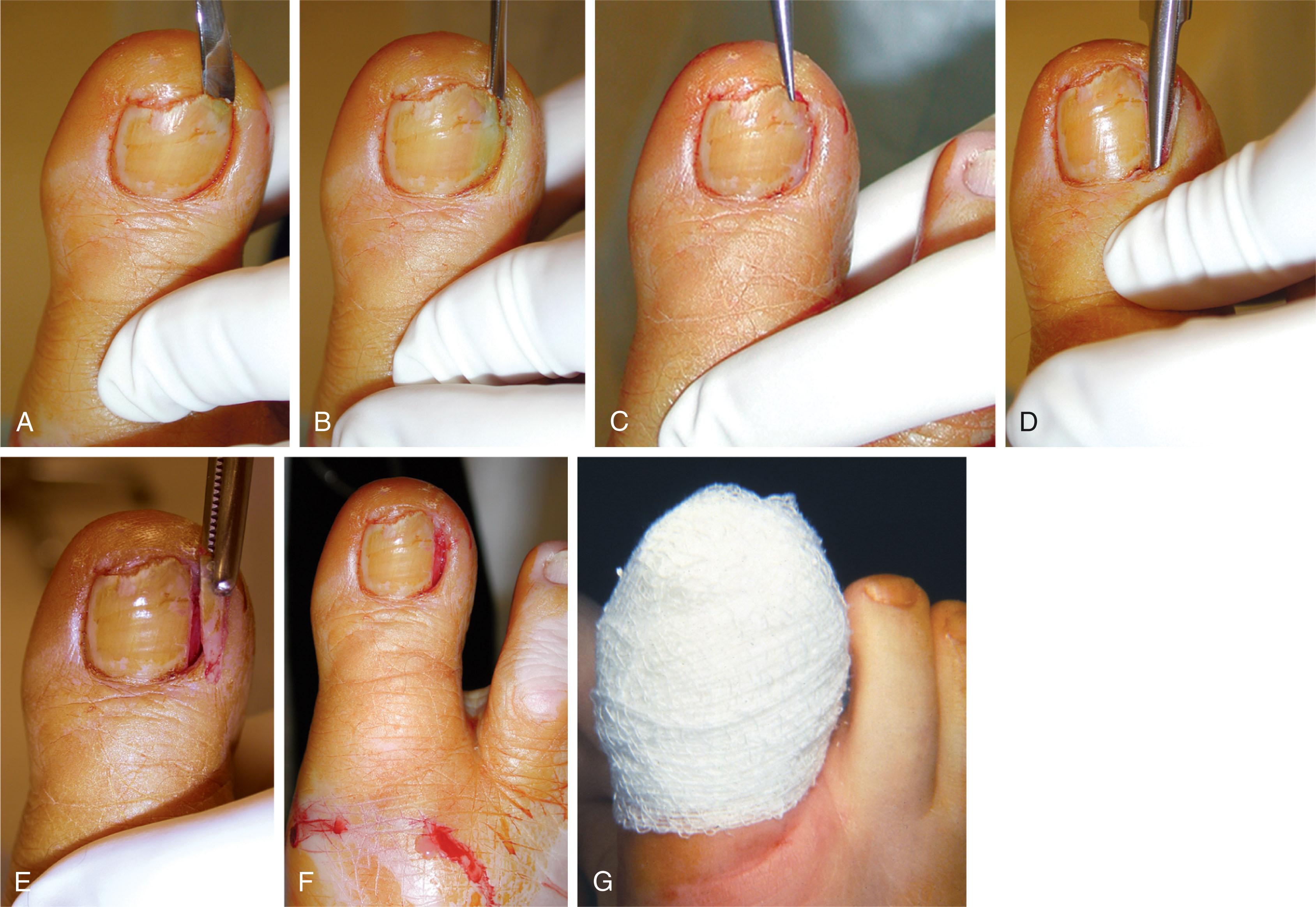
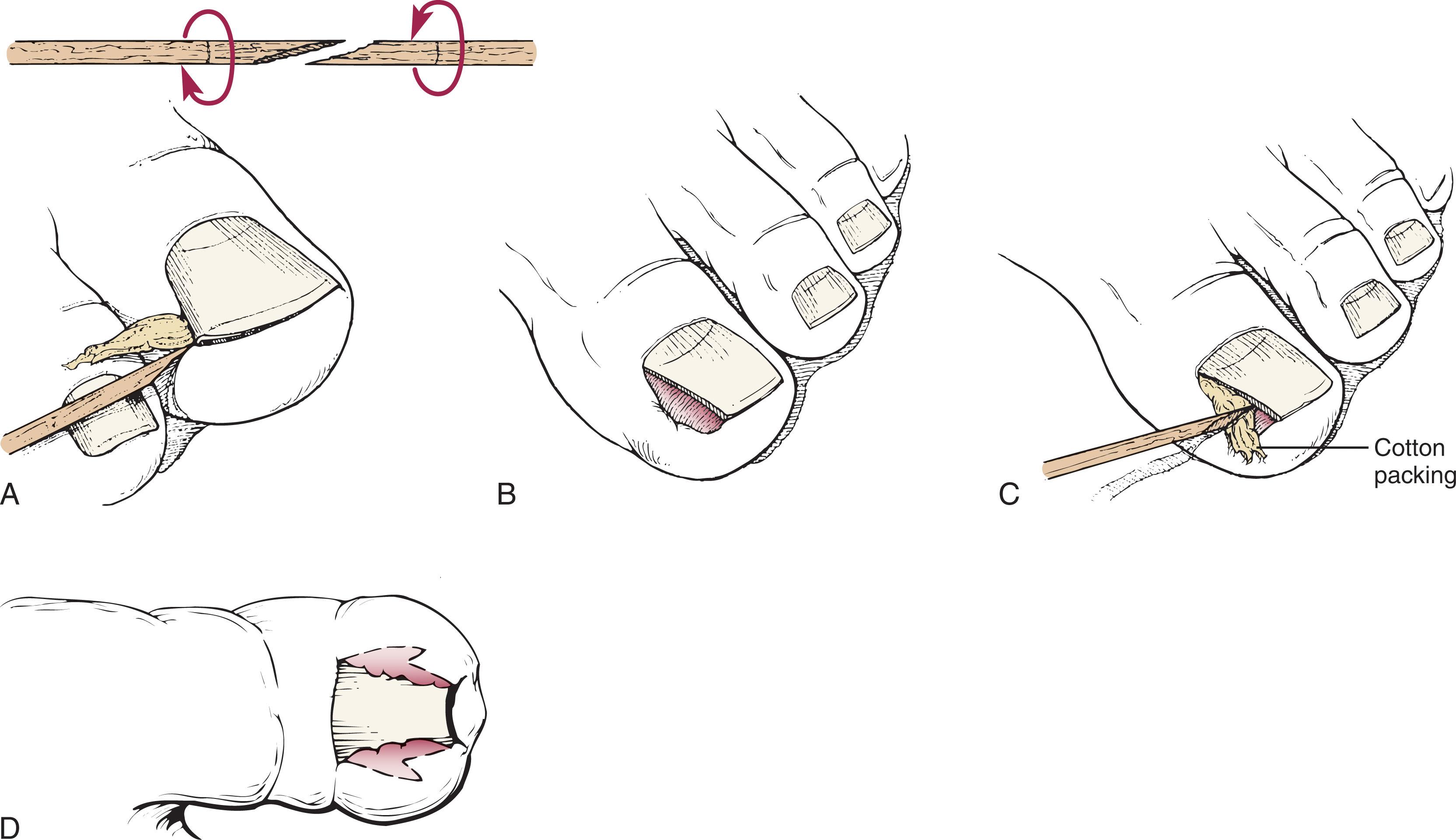
A congenitally broad nail plate predisposes to an ingrown toenail. This congenital factor explains why ingrown toenails sometimes occur in infants or even in neonates who have a broad nail plate or no free margin between the nail fold and nail plate. In adults, the condition is typically acquired. Sometimes the symptoms are so chronic and the nail changes are so severe that a terminal Syme amputation of the entire nail unit with shortening of the toe is appropriate ( Fig. 14-27 ).

The size, shape, and contour of the nail plate and bed are usually normal. Hyperplastic changes of the nail groove and fold are accompanied by formation of granulation tissue on the lip and groove. The granulation tissue bleeds freely with slight provocation. Hypertrophied tissue can cover a large part of the nail or most of the nail.
Heifetz proposed the initial classification of ingrown toenails, which has subsequently been modified to the following ( Box 14-4 ).
Stage 1: Inflammatory stage. Swelling and erythema are present along the affected (i.e., medial or lateral) nail fold. The edge of the nail plate may be embedded in an irritated nail fold.
Stage 2: Abscess stage. Increased pain accompanies acute or active infection. Drainage is present.
a. <3 mm overlap of the affected nail fold over the plate
b. >3 mm overlap of the affected nail fold over the plate
Stage 3: With chronic infection, granulation tissue develops in the affected nail fold. The surrounding soft tissue is hypertrophied.
Stage 4: Chronic deformity of the nail plate, both nail folds, and the distal fold. It is distinguished from the other stages by distal hypertrophy.
Various procedures have been reported for the cure of an ingrown toenail, but postoperative recurrence is common. Procedures generally practiced include longitudinal excision of the border of the nail plate as described above. This can temporarily resolve the infection, but a strong tendency exists for recurrent infection unless definitive treatment is performed later. Other treatments include reduction of the hypertrophied lateral fold and partial or total ablation (surgical, chemical, or laser) of the germinal matrix.
There is evidence that the second type of ingrown nail, the pincer nail ( Fig. 14-28 ), is associated with broader proximal bases of the distal phalanges, which force the nail to grow broader proximally and curve tighter distally. Bisphosphonate therapy has also been implicated as a cause of this nail deformity. Pincer nail is commonly associated with a dorsal distal osteophyte on the phalanx. Hence good therapeutic results have been achieved from a combination of removing the lateral matrix horns, lifting up the nail bed from the bone, removing the distal tuft of bone, and suturing the lateral dermis and subcutaneous tissue beneath the nail bed. This leaves “a flat nail bed with support on each side. The nail will then grow out straight.”

Unquestionably, patient education is necessary in the treatment of an ingrown toenail, both to treat an acute condition and to prevent a recurrence of infection. The patient should be instructed in proper footwear, use of loose-fitting stockings or hose, and proper nail-cutting procedures. Patients with excessive pronation may be treated with an orthotic device to decrease axial pressure on the border of the hallux. (Specific surgical procedures are discussed later in this chapter.)
Results of surgical decompression and debridement plus chemical matrixectomy have been reported. A retrospective review of 520 toes found surgical decompression had a lower recurrence rate (8.2%) compared with phenol chemical matrixectomy (17.8%), though the chemical matrixectomy group had less pain (3.6/10 vs. 5.7/10), lower risk of infection (2.9% vs. 15.3%), and slightly better cosmetic outcomes. A 2020 systematic review of both conservative and surgical treatment found 18 studies meeting inclusion criteria, but lack of validated outcome measures prohibited analysis beyond a general assessment that both treatments were generally well accepted by patients. Finally, a comparison of 10% NaOH, 88% carbolic acid (Phenol) and 90% trichloroacetic acid for chemical matrixectomy found trichloroacetic acid to have early reepithelization (27 days) compared with the NaOH group (28 days) and the Phenol group (41 days). Pain duration was also lower (1.2 days vs. 4.2 and 8.6 days, respectively) in the trichloroacetic acid group.
Onychauxis (club nail) refers to a hypertrophied nail plate. This usually involves the great toenail, but the lesser toes may be affected as well. The deformity may be caused by systemic problems, such as nutritional deficiencies or psoriasis. The toenail may be yellow, brown, gray, or black. Most cases result from local conditions, such as trauma to the nail matrix or nail bed and tinea infection, which is the most common cause. The undersurface of the nail can become tremendously thickened from the accumulation of debris from a chronic mycotic infection. The affected nail and its bed are thickened and deformed. When the disorder is caused by Microsporum gypseum , the surface of the nail might have white streaks or patches that can be excised readily. When the undersurface of the nail contains a yellowish or brown powdery substance, destruction of the nail bed has been caused by Trichophyton purpureum . In approximately 10% of cases of onychauxis, the nail bed and dorsal distal surface of the distal phalanx undergo hypertrophic changes.
Onychogryphosis refers to hypertrophy and curving of the nail plate, especially of the hallux ( Fig. 14-29 ). The nail resembles a claw or horn, and, although uncommon, its frequency in men who have tended horses has led to the appellation “hostler's toe.” It has also been referred to as “ram's horn nail.” The massive growth of the nail plate overlies the dorsal surface of the toe and often terminates on the plantar surface of the toe. This condition does not appear to have any relationship to a tinea infection. In most cases, it is the result of a congenital condition or repeated trauma to the nail matrix, along with poor hygiene. In some extreme cases, the nail measures several centimeters in length and curves on itself to resemble a ram's horn ( Fig. 14-30 ).


To treat onychogryphosis, a strong pair of special nail clippers is used to remove the entire nail horn up to where the nail is attached securely to the nail bed (see Fig. 14-29C ). Subsequent trimming and debridement help the nail become asymptomatic.
To treat onychauxis, the hypertrophied nail is gradually reduced by grinding it with a motorized tool. Abramson and Wilton advocated reducing hyperkeratotic nails with nail drills and burs. However, respiratory precautions should be observed when using these instruments, as they noted that particles 0.5 to 5 mm can become airborne and be inhaled in the respiratory tract. Chronic exposure to nail dust aerosols can lead to conjunctivitis, rhinitis, asthma, coughing, impaired lung function, and hypersensitivity. Of the physicians with chronic exposure to nail dust from grinding hyperkeratotic nails, 31% had abnormally elevated immunoglobulin E levels on radioimmunoassay.
Antifungal medication may be applied either topically or beneath the nail plate. For severely deformed club and/or gryphotic nails, avulsion of the nail is advised. Later or concurrently, the nail matrix may be ablated with a surgical ablation technique, chemical nail plate destruction, or a terminal Syme amputation. Twelve patients treated with matrixectomy and subcutaneous flap coverage had 100% successful rate of healing, suggesting avoiding a tight skin closure may help in overall healing rate. Another study describes a V-Y advancement after matrixectomy to cover the debrided region of the hallux in 14 patients, finding no complications and return to daily activities in 4.5 weeks, with good to excellent patient satisfaction in all patients at mean follow-up of 14 months.
Onychomycosis is a progressive, recurring fungal infection that originates in the nail bed and may account, directly and indirectly, for up to 50% of all toenail abnormalities. Usually, the entry is between the hyponychium and the nail plate. The infection progresses to the nail, resulting in the typical appearance of yellowing and thickening of the nail. A mycotic infection of one or more of the toenails is often preceded by or accompanied by tinea pedis (athlete's foot).
Although many people consider this primarily a cosmetic problem, a portion of the patients also experience pain (36%–48%) or limited mobility (41%) as a direct result of onychomycosis. Pressure necrosis from the nail bed or severe bacterial infections can even cause limb-threatening complications in older patients. The greatest predisposing factors are increasing age and male sex; men are 1.7 to 3.0 times more likely to have a fungal infection than women. Patients with vascular disease or diabetes, as well as immunocompromised patients (e.g., patients infected with human immunodeficiency virus [HIV]), also have a higher incidence of onychomycosis than the general population (see Table 14-15 ). With the effectiveness of the newer antifungal agents, diagnosis and treatment are more efficacious.
| Neurologic Disorders | Vascular Disorders | Metabolic Disorders | Other Systemic Disorders |
|---|---|---|---|
|
|
|
|
Zaias has classified onychomycoses into four categories ( Table 14-16 ). Distal subungual onychomycosis primarily involves the distal nail bed and hyponychium, with secondary involvement of the undersurface of the nail plate ( Figs. 14-31A and B ). Proximal subungual onychomycosis describes the scenario when organisms enter from the posterior nail fold migrating to the matrix and nail plate ultimately (see Fig. 14-31C ). White superficial onychomycosis infects the surface of the nail by such organisms as Trichophyton mentagrophytes and by Aspergillus species (see Fig. 14-31D ). Candidal onychomycosis involves the entire nail plate and is caused by Candida albicans and other species (see Fig. 14-31E ).
| Distal Subungual Onychomycosis | Proximal Subungual Onychomycosis | White Superficial Onychomycosis | Candidal Onychomycosis | |
|---|---|---|---|---|
|
|
|
|
|
|
|
|
|

Onychomycosis is a common disorder of the nail, present in possibly 20% of the population. The prevalence may be much higher than this, but culture or biopsy is not usually done. In patients older than 60 years, involvement can approach 75% of the population. Infection with dermatophytes, such as Trichophyton rubrum , T. mentagrophytes , and Epidermophyton floccosum , is much more common than with Candida species. Nondermatophytes account for less than 1% of cases of onychomycosis. More typically, Candida is the cause of infection in children.
With chronic infection, the nail plate thickens and becomes discolored, brittle, and deformed. A buildup of chronic debris beneath the nail plate occurs over time. The thickened nail plate can become detached from the underlying nail bed and become painful when compressed by tight stockings or a constricting toe box.
Distal subungual onychomycosis is the most common of the four types of mycotic infections (see Fig. 14-31A and B ). This deeply seated form of onychomycosis results in yellowish longitudinal streaks within the nail plate. Although the incubation period is unknown, the mode of transmission is thought to be through direct contact of a traumatized nail predisposed to mycotic infection. Serologic and genetic analysis of histocompatibility leukocyte antigen (HLA) class I in a homogeneous population showed that persons lacking the HLA-DR53 phenotype were at increased risk for developing Trichophyton rubrum onychomycosis. Therefore, HLA-DR53 might provide the immune response necessary to prevent a fungal infection.
The disease often occurs before the sixth decade of life. The infectious organism invades insidiously from the free edge of the nail plate toward the base, resulting in a thickened, discolored, and deformed nail plate. The initial infection occurs in the stratum corneum, the superficial layer of the epidermis. As the inflammation continues, the response of the nail bed is cellular accumulation, nail elevation, and discoloration. With the accumulation of debris beneath the nail, further fungal and microorganism growth occurs. After invading the nail bed, the fungus penetrates the nail plate and causes delamination of the toenail.
Several dermatophytes are associated with subungual onychomycosis. Trichophyton, Epidermophyton , and Microsporum are the usual dermatophytes, and T. rubrum is the most common. Trichophyton interdigitale and T. mentagrophytes can also be present, and E. floccosum and nondermatophytes ( Scopulariopsis , Aspergillus , Fusarium , and Candida species) have been reported. This disease entity is not thought to be contagious.
Endonyx onychomycosis is a variant of distal subungual onychomycosis in which the fungi reach the nail via the skin but invade the nail plate directly instead of infecting the nail bed. Endonyx onychomycosis does not cause hyperkeratosis. Despite the milky-white discoloration of the nail, the nail plate itself is of normal thickness and smooth.
White superficial onychomycosis appears as opaque, white, well-demarcated islands on the surface of the nail plate (see Fig. 14-31D ). In this infection, the pathogen invades the superficial dorsal aspect of the nail plate, which results in the development of white plaques. This is the rarest form of onychomycosis and is seldom seen except in immunologically compromised patients. The infection typically starts in the pericuticle nail plate and then grows distally, involving and destroying the entire nail plate. These plaques of localized fungal growth can progress to more diffuse involvement, invading the entire surface of the nail plate. The toenail can turn brownish and become roughened and pitted from chronic infection. The most common infectious organism is T. mentagrophytes . Topical antiseptics may be an effective early treatment for this type of onychomycosis.
Become a Clinical Tree membership for Full access and enjoy Unlimited articles
If you are a member. Log in here